Creating a stunning hot tub landscape transforms your backyard into a personal retreat that combines relaxation with visual appeal. Whether you're working with a compact urban space or an expansive backyard, the right landscaping design can enhance privacy, improve functionality, and create an atmosphere that encourages year-round enjoyment. From natural plant barriers to sophisticated structural elements, hot tub landscaping encompasses various styles including modern minimalist designs, rustic natural themes, and luxurious resort-inspired settings. The key is selecting a cohesive design approach that complements your home's architecture while addressing practical needs like maintenance access, privacy, and weather protection for the ultimate outdoor spa experience.
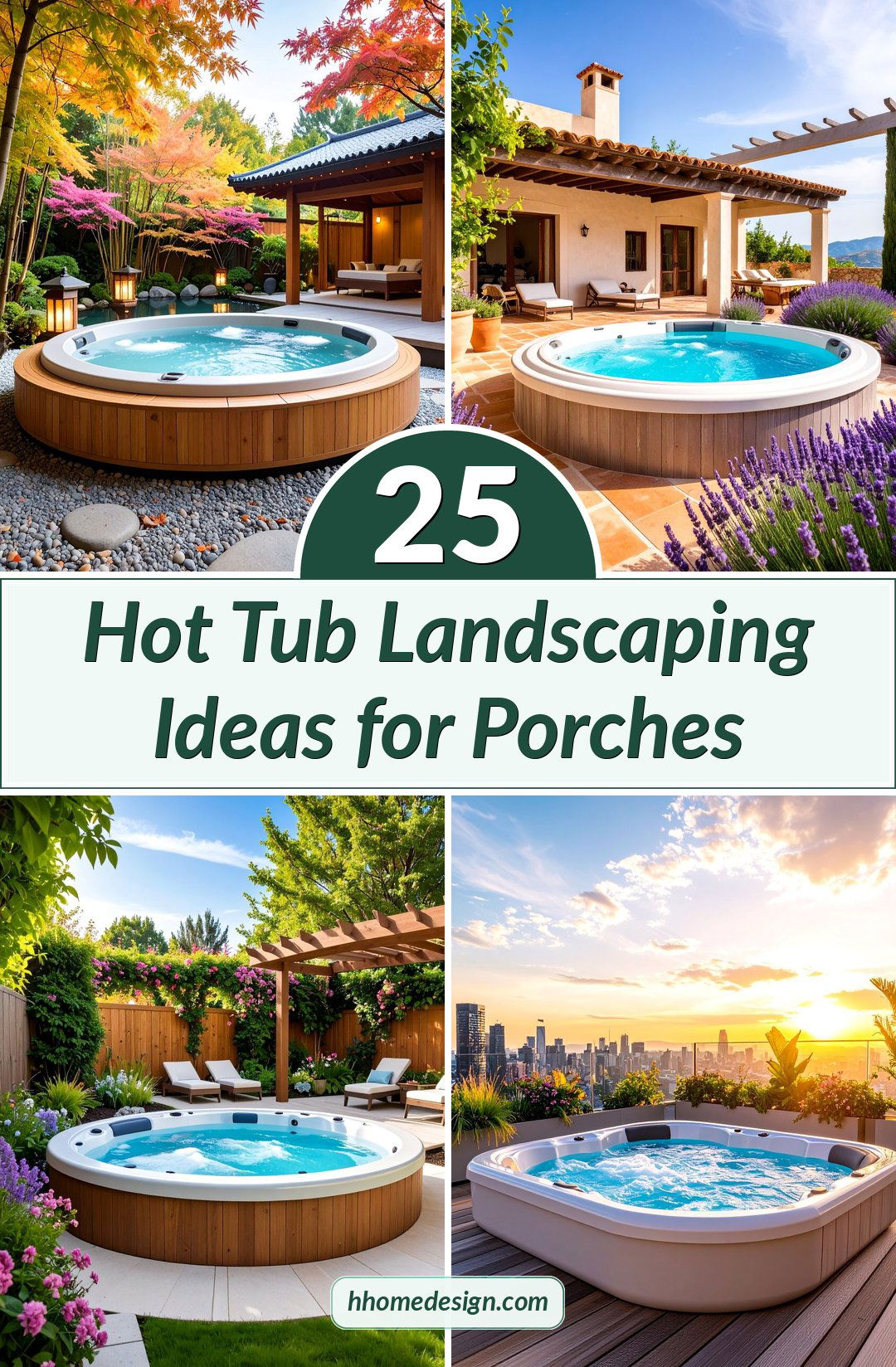
1. Bamboo Privacy Sanctuary Hot Tub

Creating a serene bamboo-enclosed hot tub area offers natural privacy with an exotic resort-like atmosphere. This design features strategically planted clumping bamboo varieties around the perimeter, creating dense vertical screens that grow quickly while maintaining controlled boundaries. The bamboo's natural rustling sounds add ambient relaxation, while the green foliage provides year-round coverage. Incorporate a simple stone or composite deck platform with natural materials like river rocks and wooden stepping stones leading to the entrance. Add subtle solar lighting along pathways and consider installing a small water feature nearby to enhance the tranquil soundscape. This low-maintenance approach works exceptionally well in various climates and offers excellent wind protection while maintaining an organic, zen-like aesthetic.
2. Sunken Stone Oasis Hot Tub

A sunken hot tub design surrounded by natural stone walls creates an intimate spa-like retreat that feels seamlessly integrated into the landscape. This approach involves partially recessing the hot tub into the ground and building attractive stone retaining walls that double as seating areas. Choose complementary stone materials like bluestone, flagstone, or local quarried rock to match your regional aesthetic. The surrounding area features wide stone coping with built-in planters filled with drought-resistant plants and ornamental grasses. Include strategically placed uplighting within the stone walls to create dramatic evening ambiance. This design effectively manages the visual bulk of above-ground hot tubs while providing excellent accessibility and creating multiple gathering spaces around the perimeter for entertaining guests.
3. Modern Pergola Covered Hot Tub
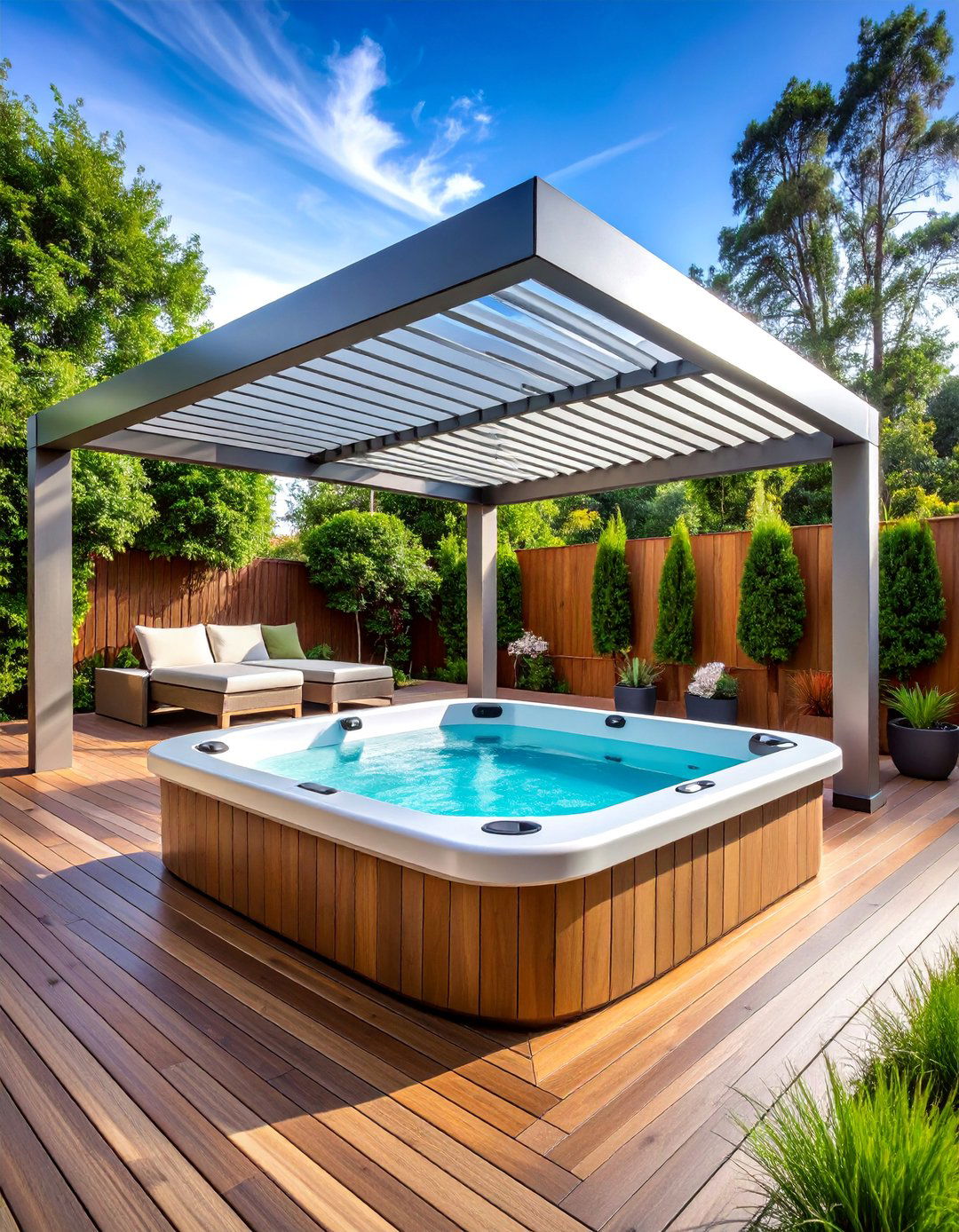
Transform your hot tub area with a sleek modern pergola that provides structured shade while maintaining an open, airy feel. This design features clean-lined aluminum or steel posts supporting adjustable louvers that allow precise control over sun exposure and weather protection. The pergola's contemporary styling complements modern home architecture while creating a defined outdoor room. Underneath, install composite decking in neutral tones with built-in LED strip lighting for evening ambiance. Surround the area with architectural plants like ornamental grasses, boxwood hedges, and specimen trees in large planters. Include retractable shade panels or outdoor curtains for additional privacy when desired. This sophisticated approach offers year-round functionality with minimal maintenance while creating a resort-style atmosphere.
4. Tropical Paradise Hot Tub Landscape
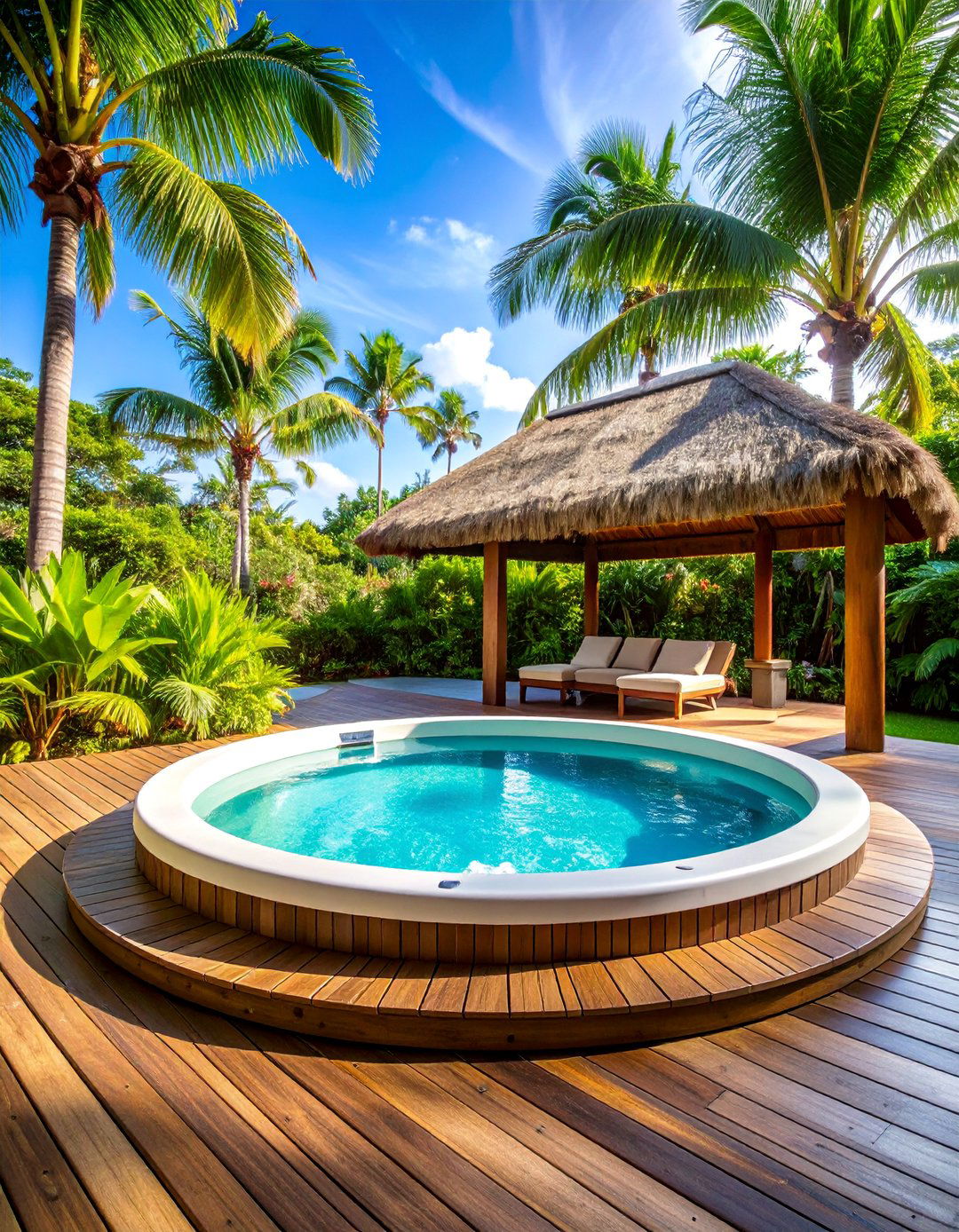
Create an exotic tropical escape with lush foliage, bold textures, and vibrant colors surrounding your hot tub area. This design incorporates large-leafed plants like palms, bird of paradise, and tropical ferns in oversized planters around a natural stone or teak deck platform. Install a thatched-roof cabana or bamboo gazebo overhead for authentic tropical flair and weather protection. Use warm-toned materials like natural teak decking, rattan furniture, and woven privacy screens. Add colorful flowering plants in tiered arrangements and incorporate water features like small fountains or cascading bowls. Include tiki torches or string lights for evening illumination. This design works particularly well in warm climates and creates an immersive vacation-like atmosphere that transports you to an island paradise.
5. Rustic Wood and Stone Hot Tub
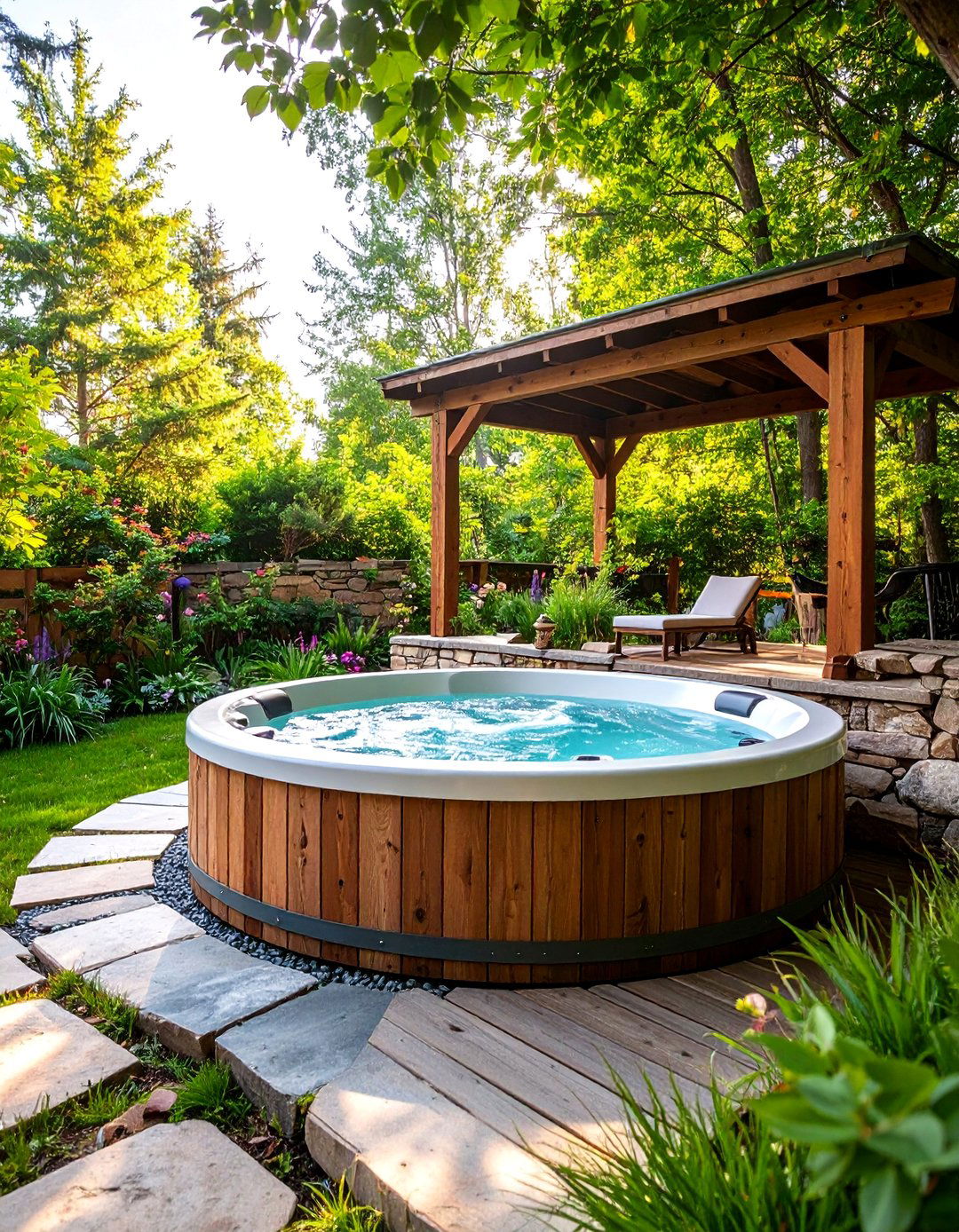
Embrace natural materials with a rustic design that combines weathered wood elements with rugged stone features around your hot tub. This approach uses reclaimed timber for decking, privacy screens, and pergola structures paired with fieldstone walls and boulders for natural landscaping. Create different elevations with stone steps and timber retaining walls filled with native plants and wildflowers. Install a cedar gazebo or log-style pavilion overhead for weather protection while maintaining the rustic aesthetic. Use natural pathways made from irregular flagstones or gravel with timber edging. Include vintage-style lighting fixtures and rustic furniture pieces. This design celebrates natural imperfections and creates a cabin-like atmosphere that feels harmonious with forested or rural settings while requiring minimal maintenance once established.
6. Japanese Zen Garden Hot Tub
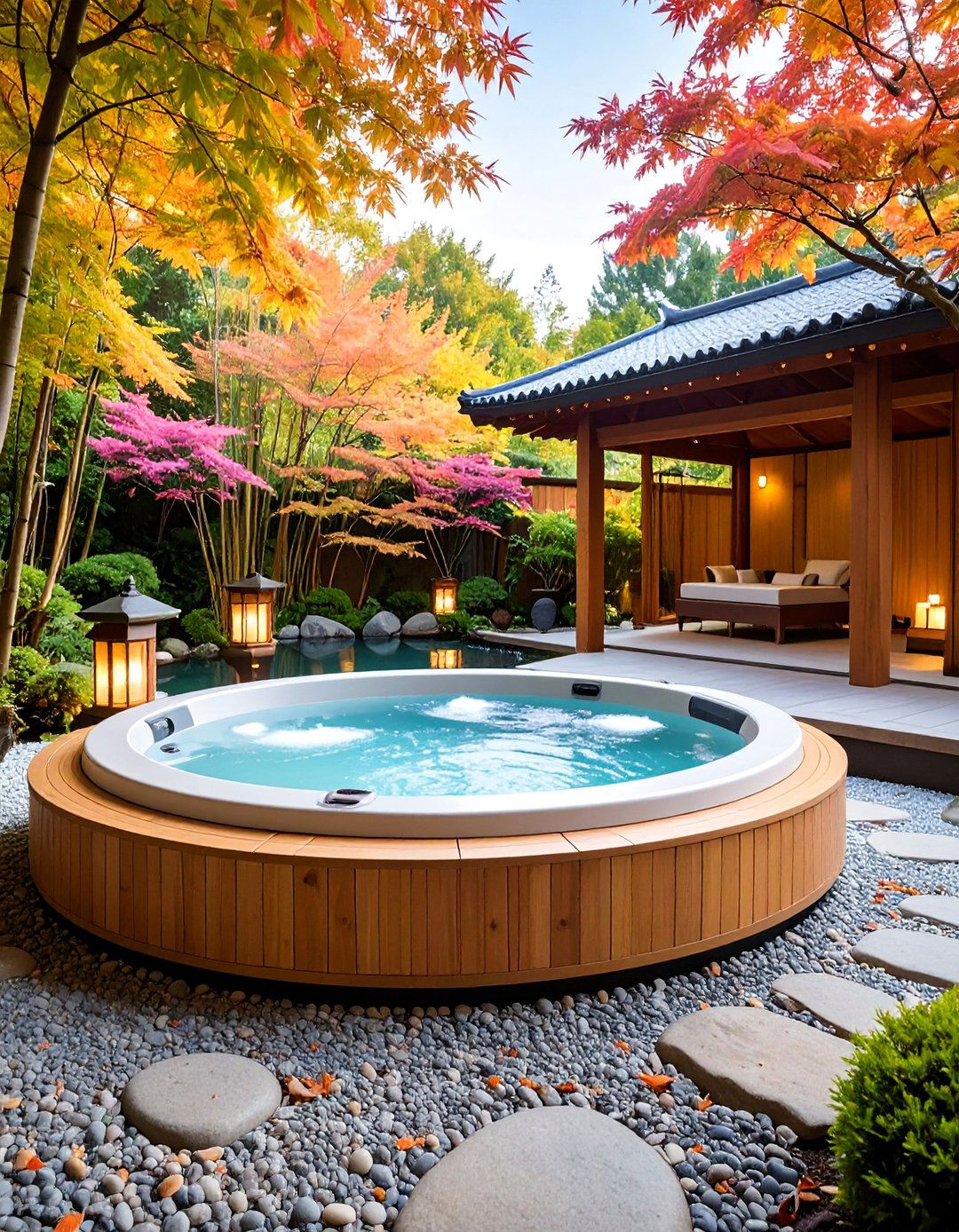
Design a peaceful Japanese-inspired landscape featuring clean lines, natural materials, and carefully curated elements that promote meditation and relaxation. This design incorporates raked gravel areas, precisely placed boulders, and minimalist plantings like Japanese maples, ornamental grasses, and moss gardens. Create a simple wooden platform using cedar or teak with clean geometric lines and built-in seating. Install a traditional pergola with horizontal slats and include elements like bamboo water features, stone lanterns, and carefully pruned shrubs. Use neutral color palettes with natural materials and maintain asymmetrical balance throughout the design. Include stepping stone pathways and consider adding a small meditation area adjacent to the hot tub. This serene approach emphasizes simplicity and natural harmony while creating a timeless aesthetic.
7. Multi-Level Deck Hot Tub Design
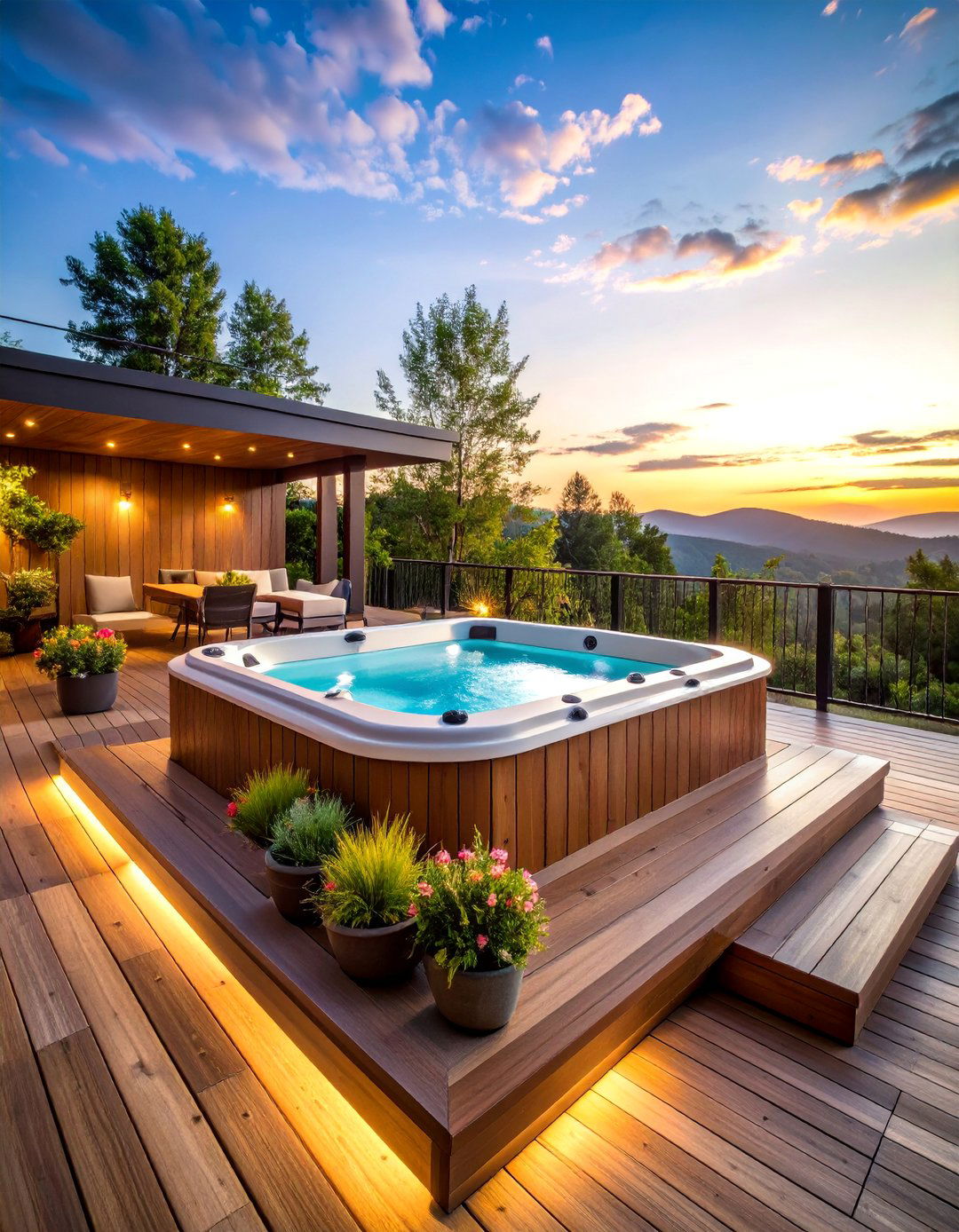
Create visual interest and functional zones with a multi-tiered deck system that incorporates your hot tub into different elevation levels for enhanced accessibility and entertainment value. This design features various deck heights connected by wide steps that serve as additional seating and display areas for planters. The hot tub sits on the main level with surrounding decking that flows into dining and lounging areas at different heights. Use consistent decking materials like composite boards or hardwood throughout while incorporating built-in planters, storage benches, and integrated lighting. Add privacy screens at strategic locations and include overhead structures like pergolas or shade sails. This approach maximizes limited space while creating distinct zones for different activities and provides excellent sight lines throughout the backyard.
8. Glass Panel Modern Privacy Hot Tub

Achieve contemporary elegance with sleek glass privacy panels that provide wind protection and visual screening while maintaining openness and light flow. This modern design features frameless or minimally framed tempered glass panels in various configurations around a streamlined hot tub installation. The glass can be clear, frosted, or tinted depending on privacy needs and aesthetic preferences. Install the panels on clean-lined metal or concrete posts with integrated lighting for evening drama. Surround the area with architectural plantings in geometric containers and use materials like polished concrete, steel, and composite decking. Include modern furniture pieces and consider adding linear water features or fire elements. This sophisticated approach works excellently in urban settings and contemporary homes while providing weather protection and noise reduction.
9. Corner Garden Retreat Hot Tub
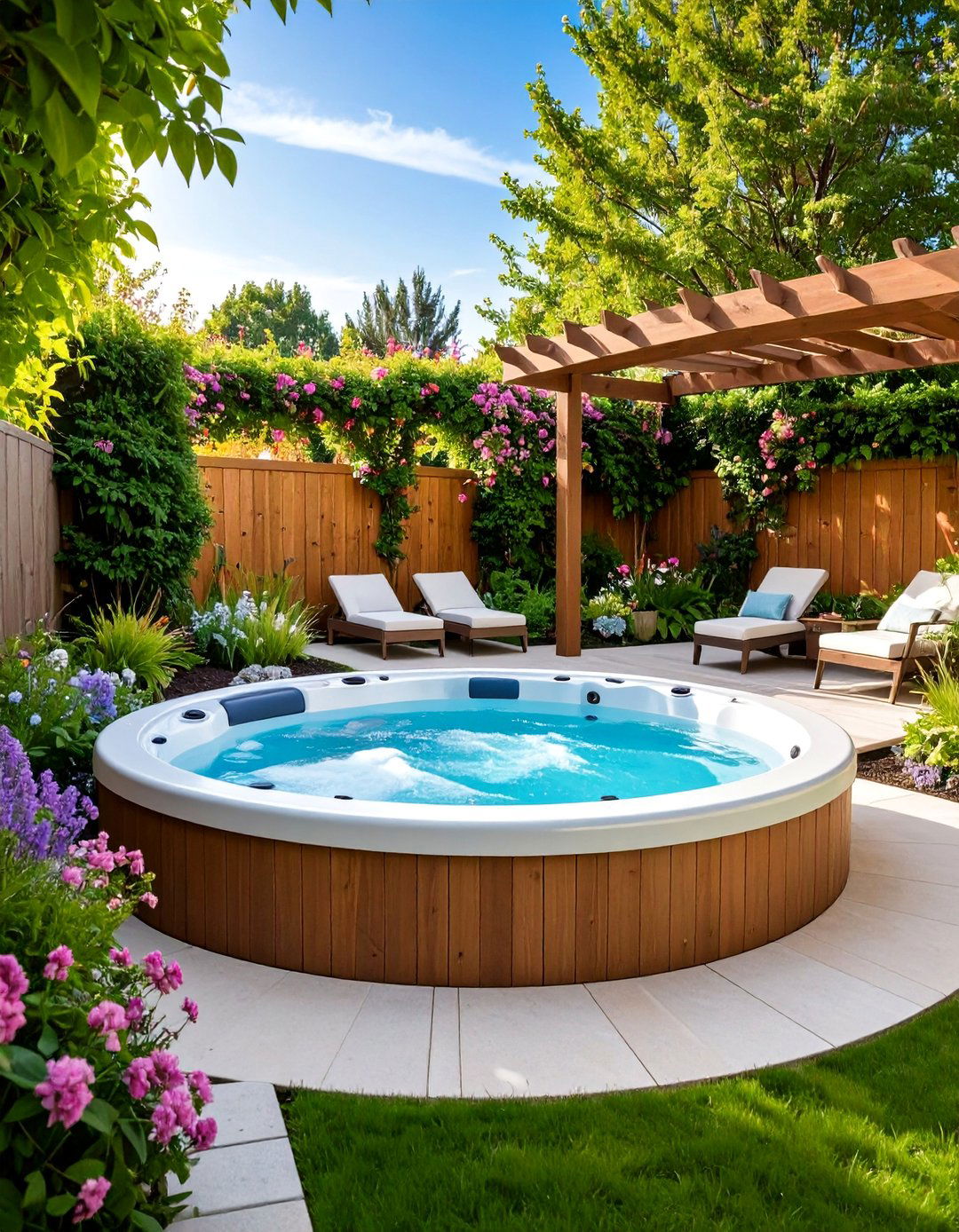
Maximize a corner location by creating an intimate garden retreat that makes efficient use of available space while providing maximum privacy and charm. This design nestles the hot tub into a corner formed by existing structures like fences, walls, or buildings and fills the area with layered landscaping. Use curved pathways, tiered plantings, and varied textures to create depth and visual interest in the compact space. Install a corner pergola or gazebo that spans both adjacent walls for structural support and weather protection. Include vertical gardening elements like trellises with climbing plants, wall-mounted planters, and hanging baskets. Use space-saving furniture and built-in storage solutions. This approach transforms underutilized corners into charming outdoor sanctuaries that feel much larger than their actual footprint suggests.
10. Pool and Hot Tub Integration Design
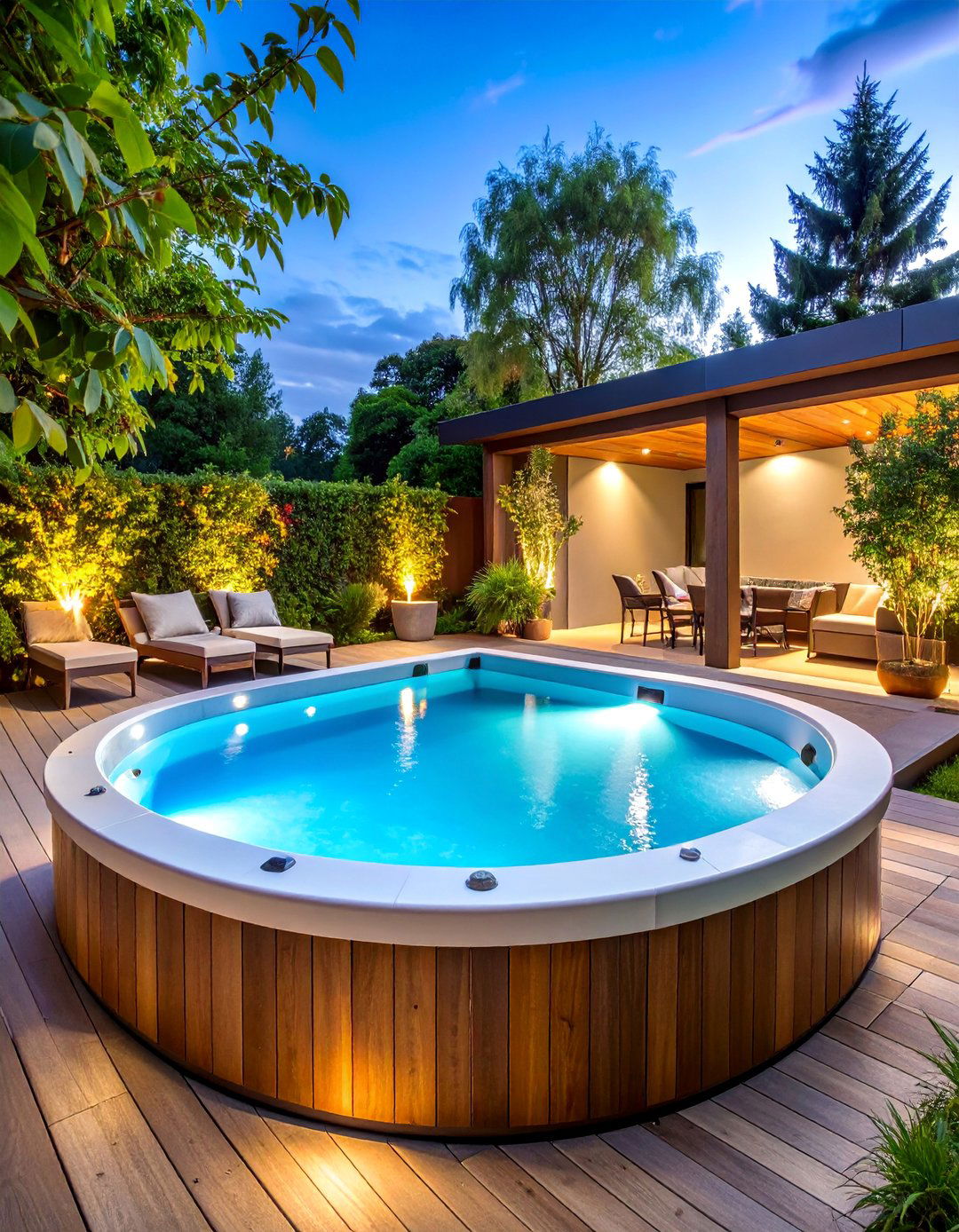
Create a cohesive aquatic environment by designing your hot tub as a complementary feature to an existing or planned swimming pool with matching materials and coordinated landscaping. This design uses consistent coping materials, tile selections, and decking choices to create visual continuity between both water features. Position the hot tub at pool level or slightly elevated with connecting spillways or adjacent placement. Surround both features with unified landscaping using drought-resistant plants, decorative rocks, and shade structures that serve both areas. Include shared lighting systems, furniture groupings, and entertainment features like outdoor bars or fire pits. This integrated approach creates a resort-style backyard with multiple activity zones while maintaining design cohesion and maximizing the impact of your outdoor investment.
11. Rooftop Urban Hot Tub Oasis

Transform urban rooftop spaces into sophisticated hot tub retreats that maximize city views while providing privacy and weather protection in challenging environments. This design addresses weight limitations, wind exposure, and privacy concerns while creating a luxurious escape above the cityscape. Use lightweight composite decking, aluminum pergolas, and container gardening with wind-resistant plants like ornamental grasses and compact evergreens. Install privacy screens that don't obstruct desirable views while blocking unwanted sightlines. Include weather-resistant furniture, retractable shade elements, and wind barriers for year-round comfort. Consider lightweight water features, built-in storage for equipment, and efficient drainage systems. This sophisticated approach creates an exclusive urban retreat that feels removed from street-level activity while taking advantage of unique elevated perspectives and often spectacular views.
12. Natural Rock Formation Hot Tub
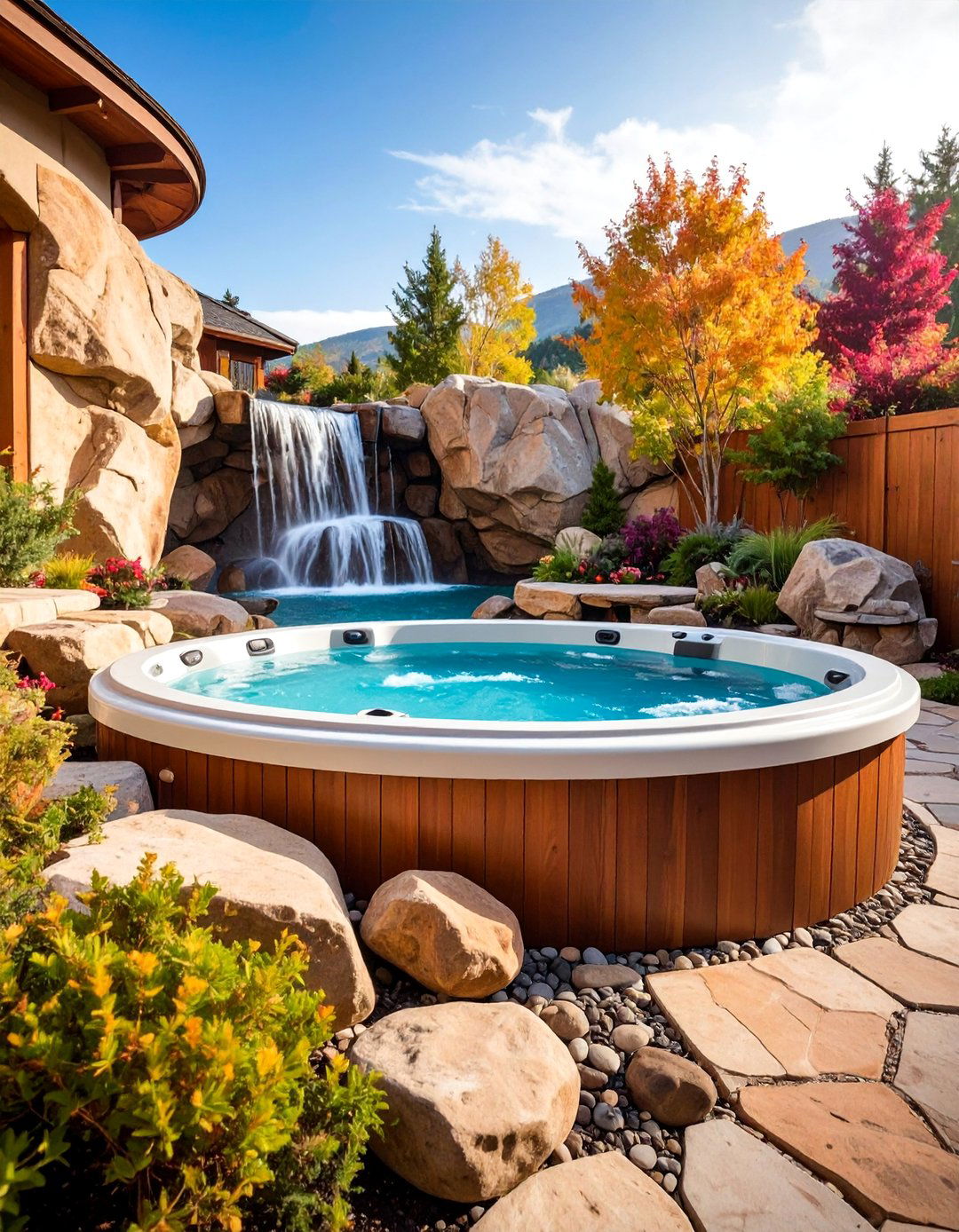
Integrate your hot tub into a naturalistic rock landscape that mimics geological formations with boulders, outcroppings, and cascading water features for an authentic outdoor spa experience. This design uses large natural stones to create tiered levels, retaining walls, and sculptural elements that make the hot tub appear nestled within a natural setting. Include rock-lined pathways, boulder groupings, and integrated planting pockets filled with alpine plants, succulents, and native species. Add water features like rock waterfalls, natural pools, or bubbling springs that complement the hot tub's aquatic theme. Use natural materials for any structural elements and avoid geometric shapes in favor of organic curves and irregular forms. This approach creates a timeless landscape that feels like a natural hot spring while providing excellent drainage and low-maintenance beauty.
13. Garden Gazebo Hot Tub Pavilion

Create a classic outdoor room with a traditional gazebo structure that provides complete weather protection while maintaining elegant architectural details and garden integration. This design features a substantial wooden or vinyl gazebo with a solid roof, decorative railings, and built-in seating around the hot tub perimeter. The gazebo structure includes features like ceiling fans, integrated lighting, and optional side panels for seasonal weather protection. Surround the pavilion with formal or cottage-style gardens featuring flowering perennials, climbing roses, and foundation plantings that complement the structure's architectural style. Include pathways, garden borders, and coordinating outdoor furniture. This approach provides maximum weather protection and creates a permanent outdoor room that can be enjoyed year-round while serving as a focal point for the entire backyard landscape.
14. Desert Oasis Hot Tub Landscape
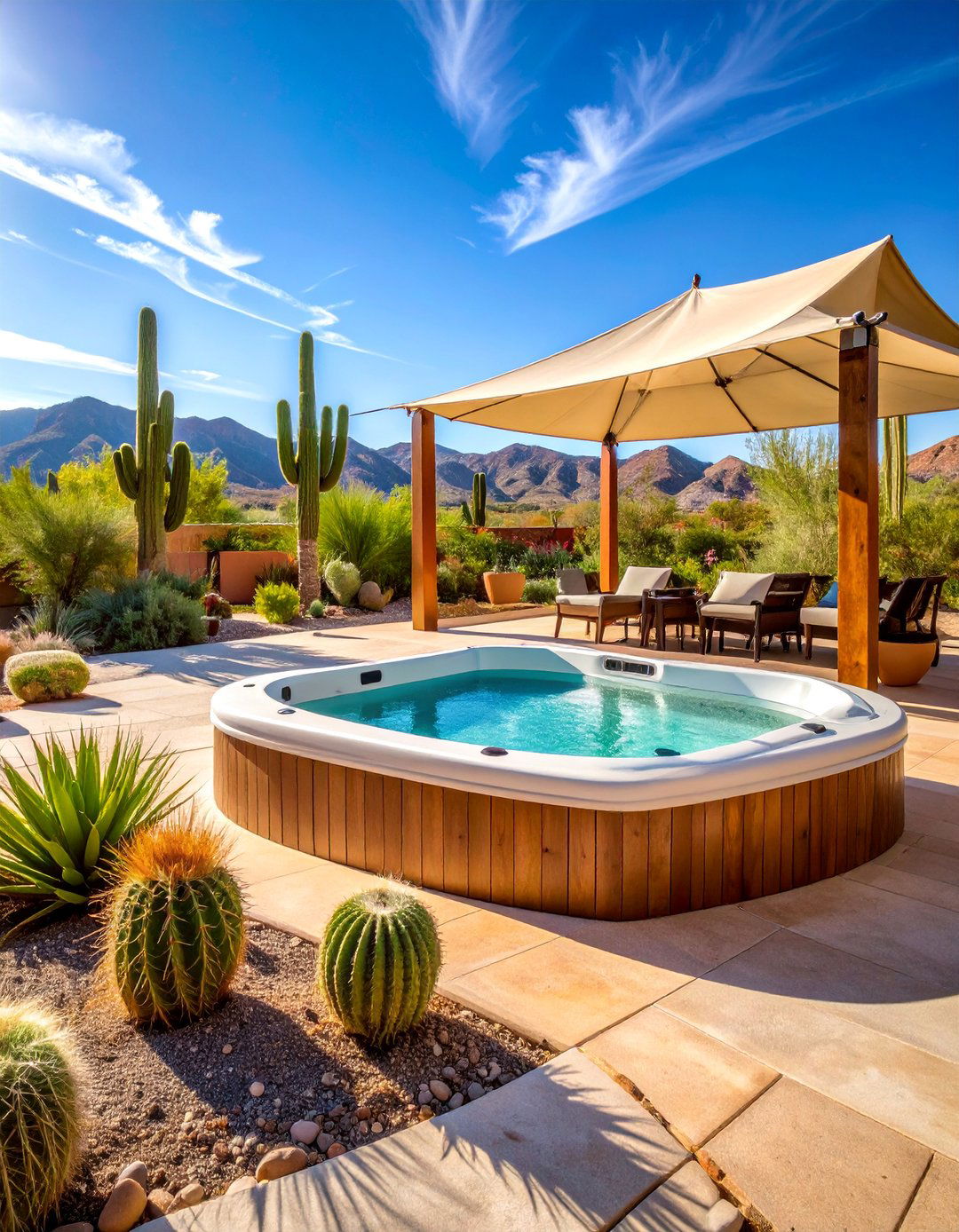
Design a water-wise desert landscape that celebrates arid beauty with drought-resistant plants, natural materials, and efficient water management around your hot tub area. This design incorporates architectural cacti, colorful succulents, and native desert plants in gravel gardens with decorative rock mulches. Use materials like decomposed granite pathways, flagstone patios, and adobe-inspired walls to create southwestern character. Include shade structures made from natural materials like ramadas or modern shade sails. Add desert-appropriate water features like fountain bowls or olla pots for ambient sound without excessive water use. Install efficient irrigation systems and use reflective materials to manage heat. This sustainable approach creates a stunning landscape that requires minimal water and maintenance while providing a unique aesthetic that celebrates natural desert beauty.
15. Woodland Forest Hot Tub Sanctuary

Create an immersive forest experience by integrating your hot tub into a naturalistic woodland setting with native trees, understory plants, and natural materials that blend seamlessly with existing vegetation. This design preserves and enhances natural features while creating clearings and pathways that lead to the hot tub area. Use materials like natural flagstone, timber decking, and rustic pergolas that complement the forest environment. Plant native ferns, wildflowers, and shade-loving perennials in informal drifts around existing trees. Include natural pathways made from wood chips, stepping stones, or boardwalks that minimize environmental impact. Add subtle lighting that highlights natural features without overwhelming the forest atmosphere. This approach creates a private retreat that feels like a natural hot spring while supporting local wildlife and maintaining ecological balance.
16. Coastal Beach Theme Hot Tub

Capture coastal ambiance with weathered materials, salt-tolerant plants, and beach-inspired design elements that evoke seaside relaxation and ocean breezes around your hot tub area. This design uses materials like weathered cedar, natural rope, and sea glass accents combined with coastal plants like ornamental grasses, beach roses, and salt-tolerant perennials. Create sandy pathways, driftwood accents, and nautical lighting fixtures for authentic coastal character. Include wind-resistant shade structures and furniture that can withstand salt air and moisture. Add water features that suggest ocean sounds and use color palettes inspired by sea, sand, and sky. Install outdoor showers and include storage for beach accessories. This relaxed approach creates a vacation atmosphere that celebrates coastal living while providing protection from wind and salt exposure typical of seaside environments.
17. Fire and Water Elements Hot Tub
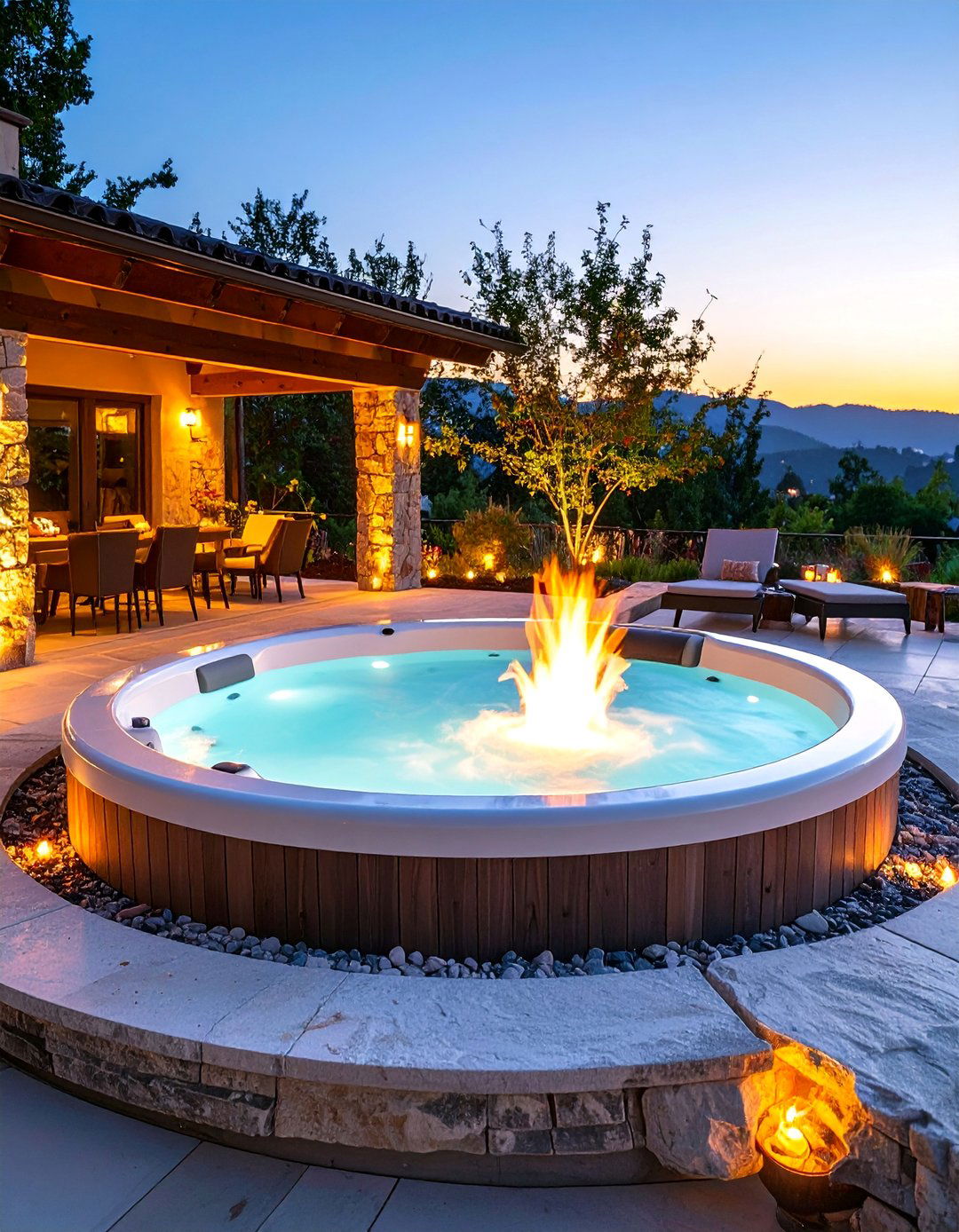
Combine the primal elements of fire and water by incorporating fire features, warming elements, and dramatic lighting that create a captivating sensory experience around your hot tub area. This design includes fire pits, fire bowls, or linear fire features positioned safely away from the hot tub while providing visual interest and additional warmth for cooler evenings. Use fire-resistant materials like natural stone, concrete, or metal for structural elements. Include seating areas around fire features and design pathways that connect different activity zones. Add dramatic lighting that highlights both fire and water elements while providing safety illumination. Consider wind patterns when positioning fire features and include safety barriers as needed. This dynamic approach creates year-round entertainment value while extending the usable seasons for outdoor enjoyment and creating memorable evening experiences.
18. Mediterranean Villa Hot Tub Garden

Create Old World charm with Mediterranean-inspired design elements including terracotta materials, aromatic herbs, and architectural details that evoke Italian or Spanish villa gardens. This design features warm-toned materials like terra cotta tiles, natural stone, and wrought iron combined with drought-resistant plants like lavender, rosemary, and olive trees. Include formal elements like symmetrical plantings, decorative urns, and classical architectural details while maintaining intimate scale. Add pergolas with climbing vines, courtyards with fountain features, and outdoor dining areas with authentic furniture. Use warm color palettes and natural materials throughout while incorporating efficient irrigation for plant health. This timeless approach creates sophisticated outdoor living spaces that feel elegant and established while providing excellent year-round beauty and functionality in suitable climates.
19. Asian Spa Inspired Hot Tub Design
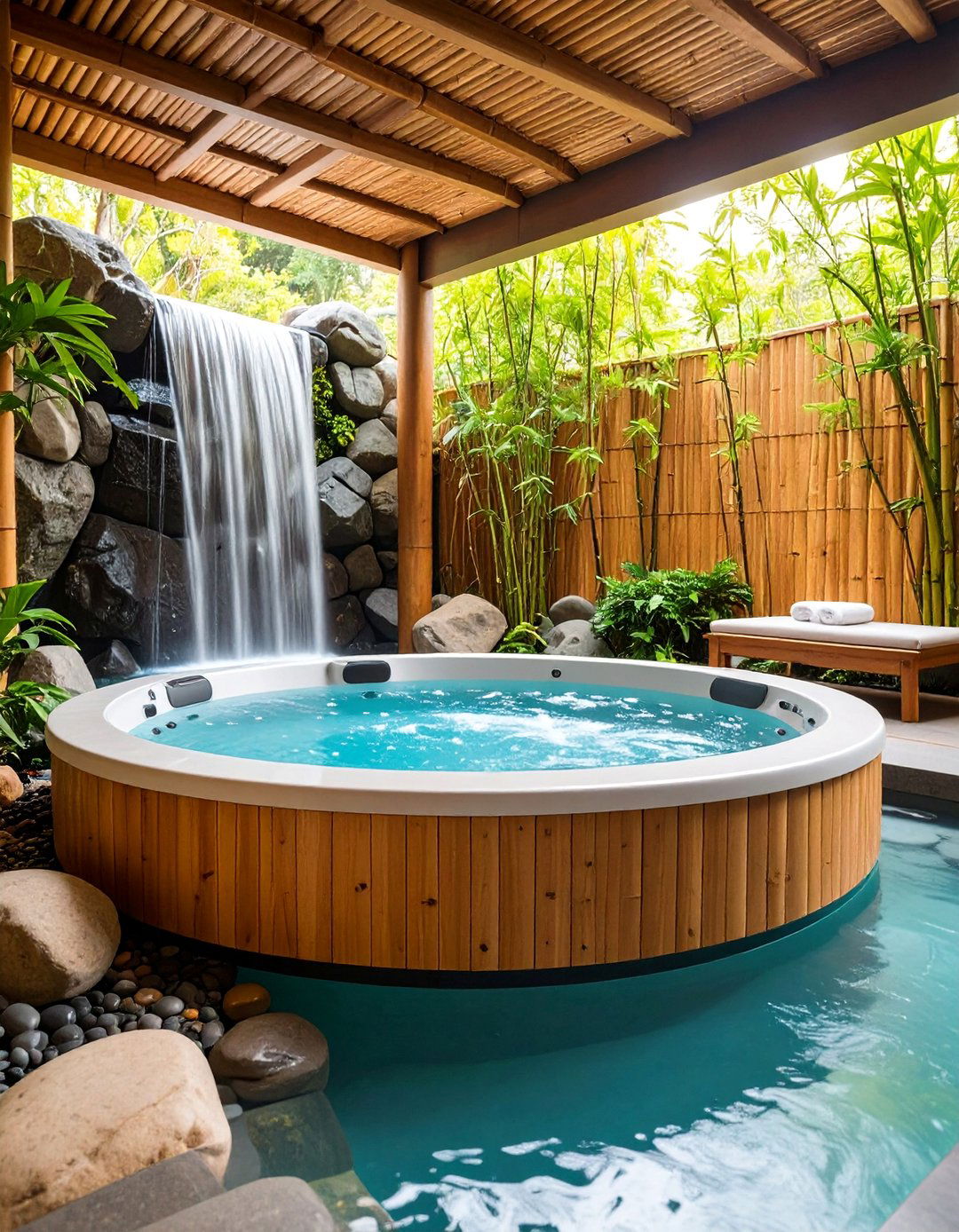
Design a tranquil Asian-inspired spa environment with natural materials, water features, and carefully composed elements that promote relaxation and mindfulness around your hot tub area. This design incorporates elements like natural bamboo, river rocks, and carefully pruned plants in asymmetrical arrangements that create visual balance and harmony. Include features like cascading water walls, meditation areas, and walking paths made from natural materials. Use neutral color palettes with occasional accent colors from flowering plants or decorative elements. Add traditional lighting like paper lanterns or stone fixtures and include seating areas for quiet contemplation. Consider incorporating feng shui principles in the layout and plant selection. This peaceful approach creates a retreat atmosphere that encourages relaxation and stress relief while maintaining sophisticated aesthetic appeal that complements various architectural styles.
20. Entertainment Hub Hot Tub Landscape

Design a social entertainment space that positions your hot tub as the centerpiece of a larger outdoor living area with features for dining, entertaining, and year-round gathering. This design includes outdoor kitchens, bar areas, dining spaces, and lounge zones arranged around the hot tub for easy flow between activities. Use durable materials like natural stone, composite decking, and weather-resistant furniture that can handle frequent use and various weather conditions. Include features like outdoor televisions, sound systems, and adequate lighting for evening entertainment. Add shade structures, heating elements, and storage for entertainment accessories. Design pathways and traffic flow that accommodate groups while maintaining intimate conversation areas. This comprehensive approach creates a backyard resort that encourages frequent use and social interaction while providing comfort and convenience for hosts and guests.
21. Geometric Modern Minimalist Hot Tub

Create a sophisticated minimalist design with clean geometric lines, limited material palette, and architectural plantings that emphasize form and function over decorative elements. This design features simple rectangular or square layouts with materials like polished concrete, steel, and composite materials in neutral colors. Use architectural plants like ornamental grasses, columnar trees, and structured hedges in geometric arrangements. Include built-in seating, storage, and lighting that maintain clean lines and minimal visual clutter. Add single-color plantings or monochromatic schemes that complement the architectural elements. Consider incorporating water features with geometric forms and use furniture with simple, modern profiles. This refined approach creates timeless outdoor spaces that complement contemporary architecture while requiring minimal maintenance and providing maximum visual impact through careful attention to proportion, scale, and material selection.
22. Cottage Garden Hot Tub Hideaway
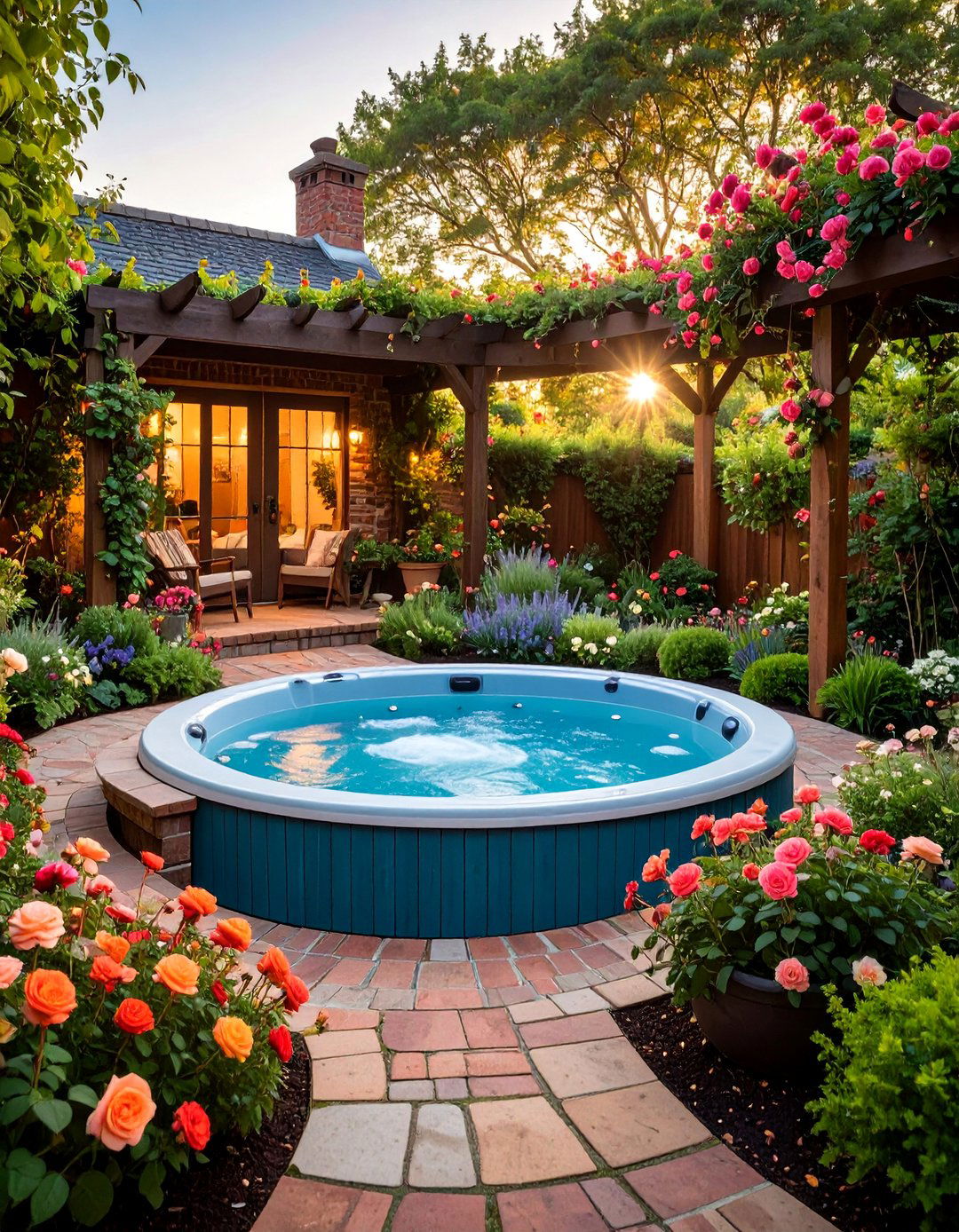
Design a charming cottage-style landscape with informal plantings, traditional materials, and cozy features that create an intimate retreat surrounded by abundant flowering plants and rustic elements. This design includes mixed perennial borders, climbing roses, cottage garden favorites, and informal pathways made from brick, gravel, or flagstone. Use traditional materials like painted wood, picket fencing, and vintage-inspired furniture and accessories. Include features like arbors, trellises, and garden sheds that complement the cottage aesthetic. Add abundant flowering plants in informal drifts and include herb gardens and cutting gardens for practical and aesthetic value. Use soft color palettes and natural materials throughout while maintaining the relaxed, informal character typical of cottage gardens. This charming approach creates welcoming outdoor spaces that feel established and comfortable while providing seasonal interest and natural beauty.
23. Industrial Chic Hot Tub Design

Create an urban industrial aesthetic using raw materials like concrete, steel, and reclaimed wood combined with architectural elements that celebrate industrial design principles around your hot tub area. This design features polished concrete pads, steel pergolas, and exposed structural elements combined with contemporary plantings in geometric containers. Use materials like corten steel, galvanized metal, and concrete blocks in simple, functional arrangements. Include industrial-style lighting, furniture with metal frameworks, and accessories that complement the raw material palette. Add architectural plants that provide softening contrast without compromising the industrial character. Consider incorporating elements like water features with steel or concrete components and use efficient, low-maintenance landscaping approaches. This sophisticated approach creates unique outdoor spaces that complement loft-style homes and urban environments while providing durability and minimal maintenance requirements.
24. Hillside Terraced Hot Tub Installation

Work with sloped terrain by creating terraced levels that accommodate your hot tub while managing drainage, erosion, and accessibility challenges common to hillside locations. This design uses retaining walls, stepped levels, and terraced plantings to create usable outdoor space on challenging slopes. Include materials like natural stone, timber, or concrete blocks for structural elements and design pathways that provide safe access between levels. Add plantings that provide erosion control while creating visual interest and privacy. Include drainage systems that manage water runoff and consider automated irrigation for terraced plantings. Design seating areas and gathering spaces at different levels to take advantage of views and create intimate conversation areas. This challenging approach transforms difficult terrain into functional outdoor living space while providing unique perspectives and dramatic landscape features.
25. Four-Season All-Weather Hot Tub Enclosure
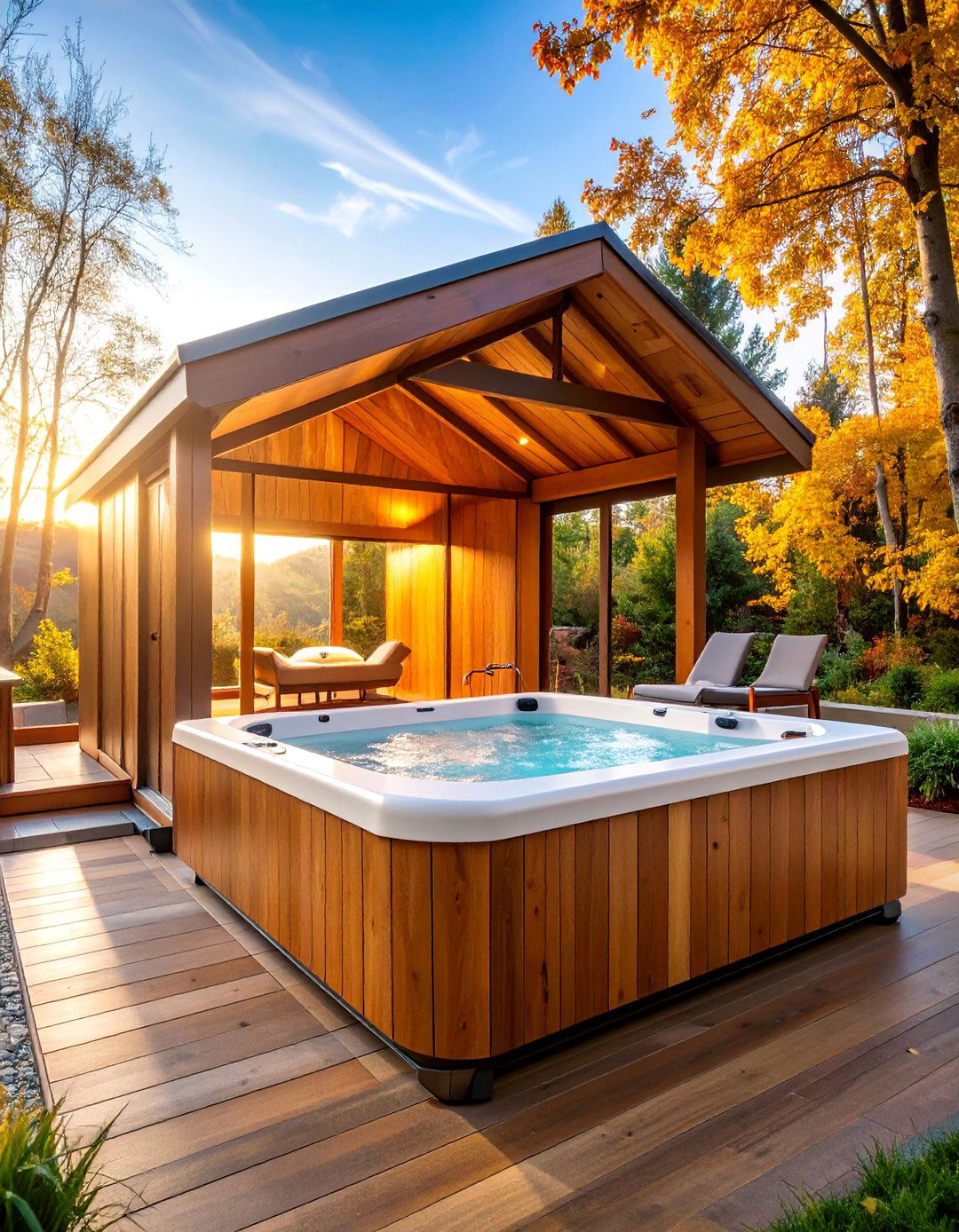
Design a comprehensive weather protection system that allows year-round hot tub enjoyment regardless of climate conditions while maintaining connection to the outdoor environment. This design includes retractable roofs, removable side panels, and heating elements that can be adjusted seasonally. Use materials like aluminum framing, tempered glass, and weatherproof fabrics that provide protection without permanent enclosure. Include features like radiant heaters, wind screens, and efficient ventilation systems for comfort in various weather conditions. Add seasonal plantings in containers that can be moved or protected during harsh weather and design storage for seasonal accessories and equipment. Consider automated systems for adjusting protection levels and include drainage systems for rain and snow management. This comprehensive approach extends the usable season while providing flexibility to adapt to changing weather conditions and personal preferences.
Conclusion:
Successful hot tub landscaping combines aesthetic appeal with practical functionality to create outdoor spaces that enhance relaxation and provide year-round enjoyment. Whether you choose natural materials that blend with existing landscapes or modern elements that make bold architectural statements, the key is selecting a cohesive design approach that addresses your specific needs for privacy, weather protection, and maintenance requirements. Each design theme offers unique benefits and can be adapted to different climates, budgets, and personal preferences while creating a personalized retreat that adds value to your home and improves your quality of life.


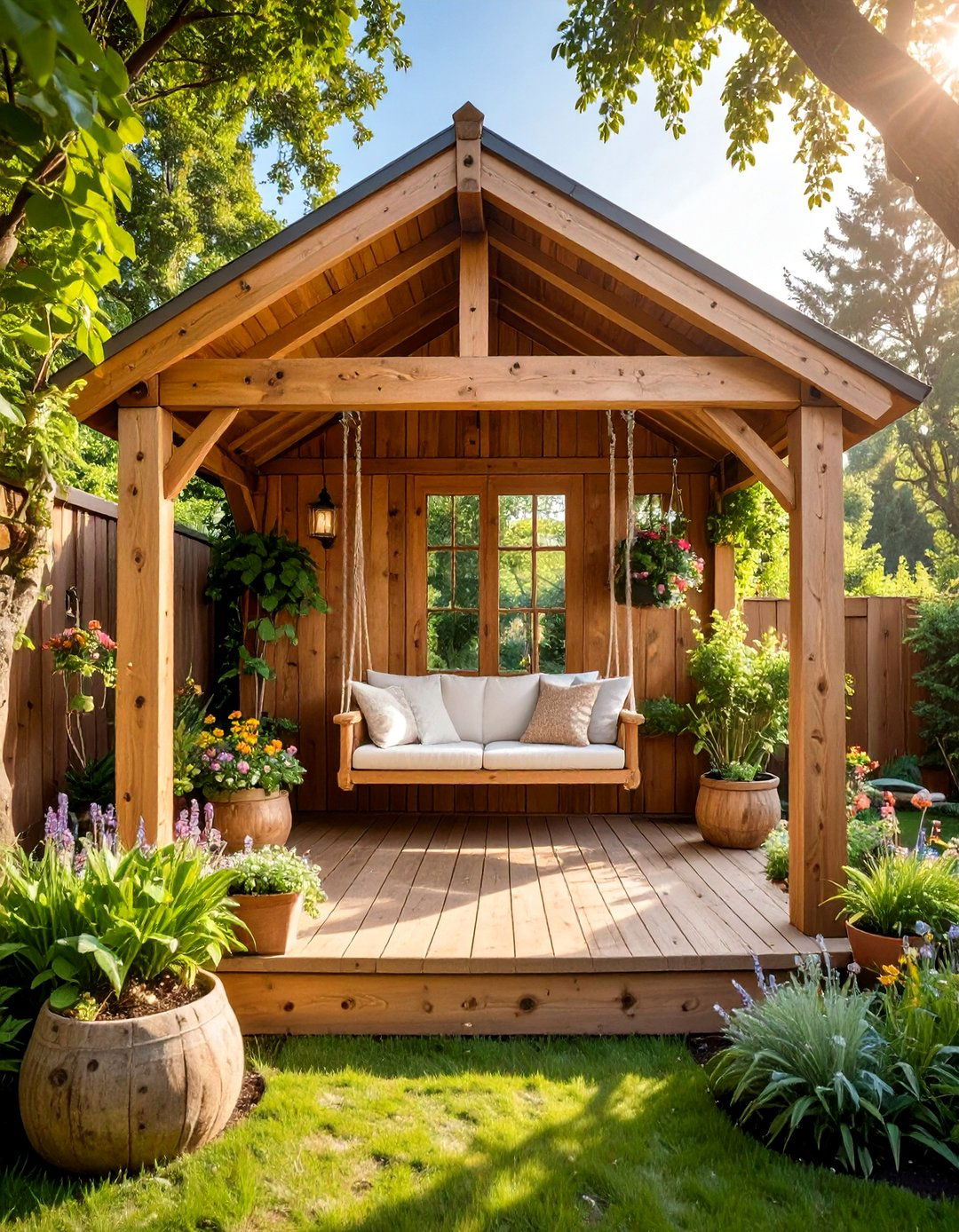
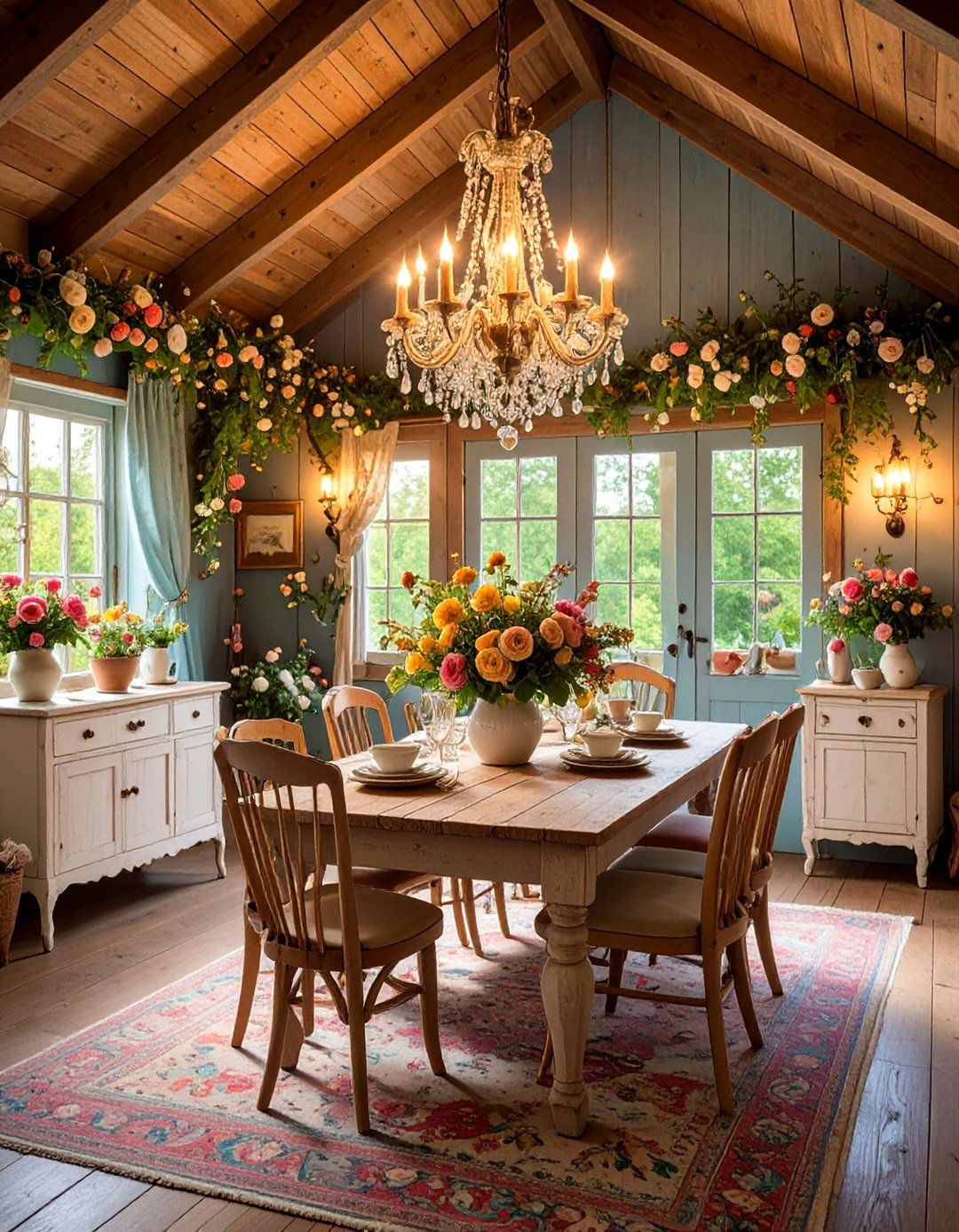


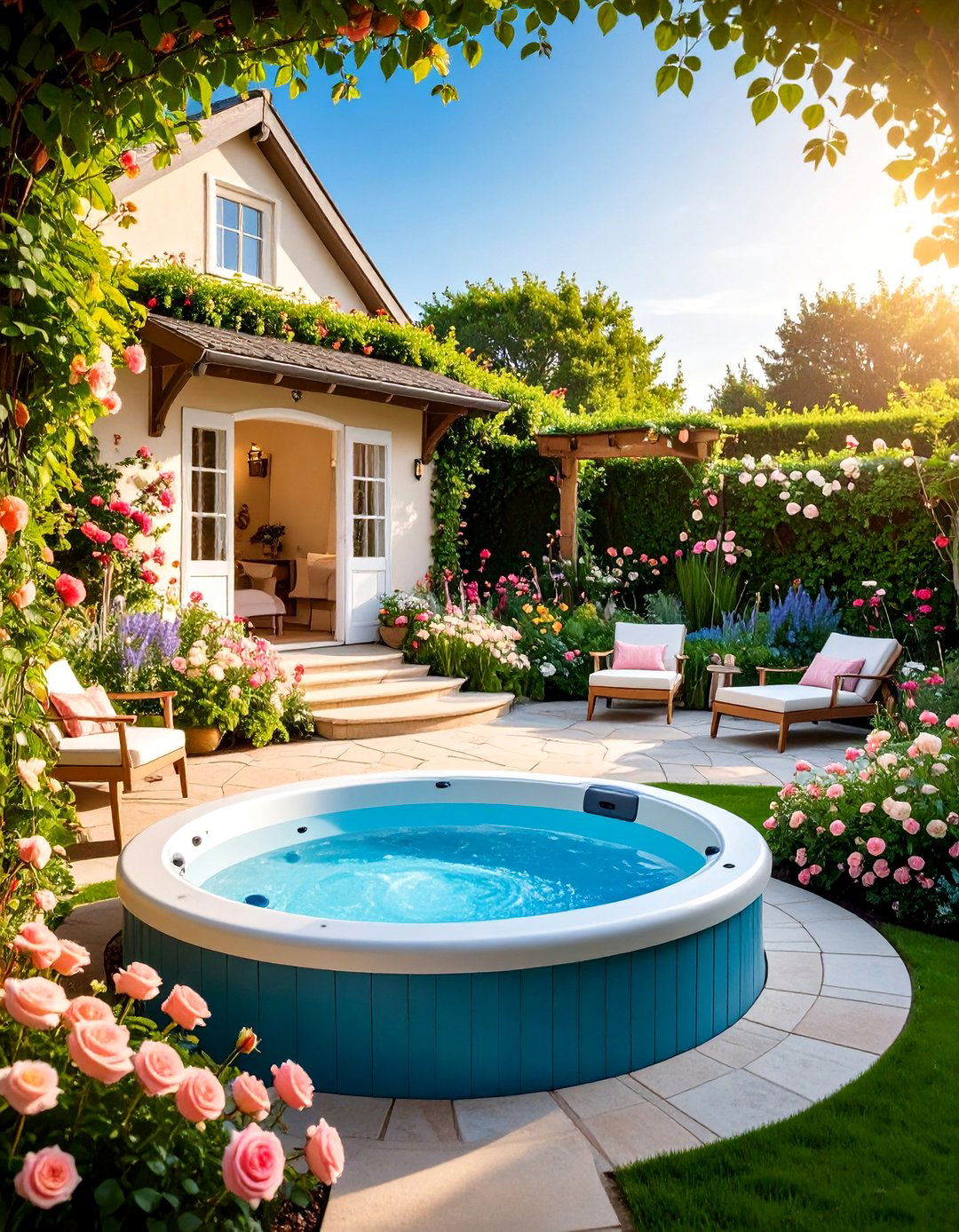
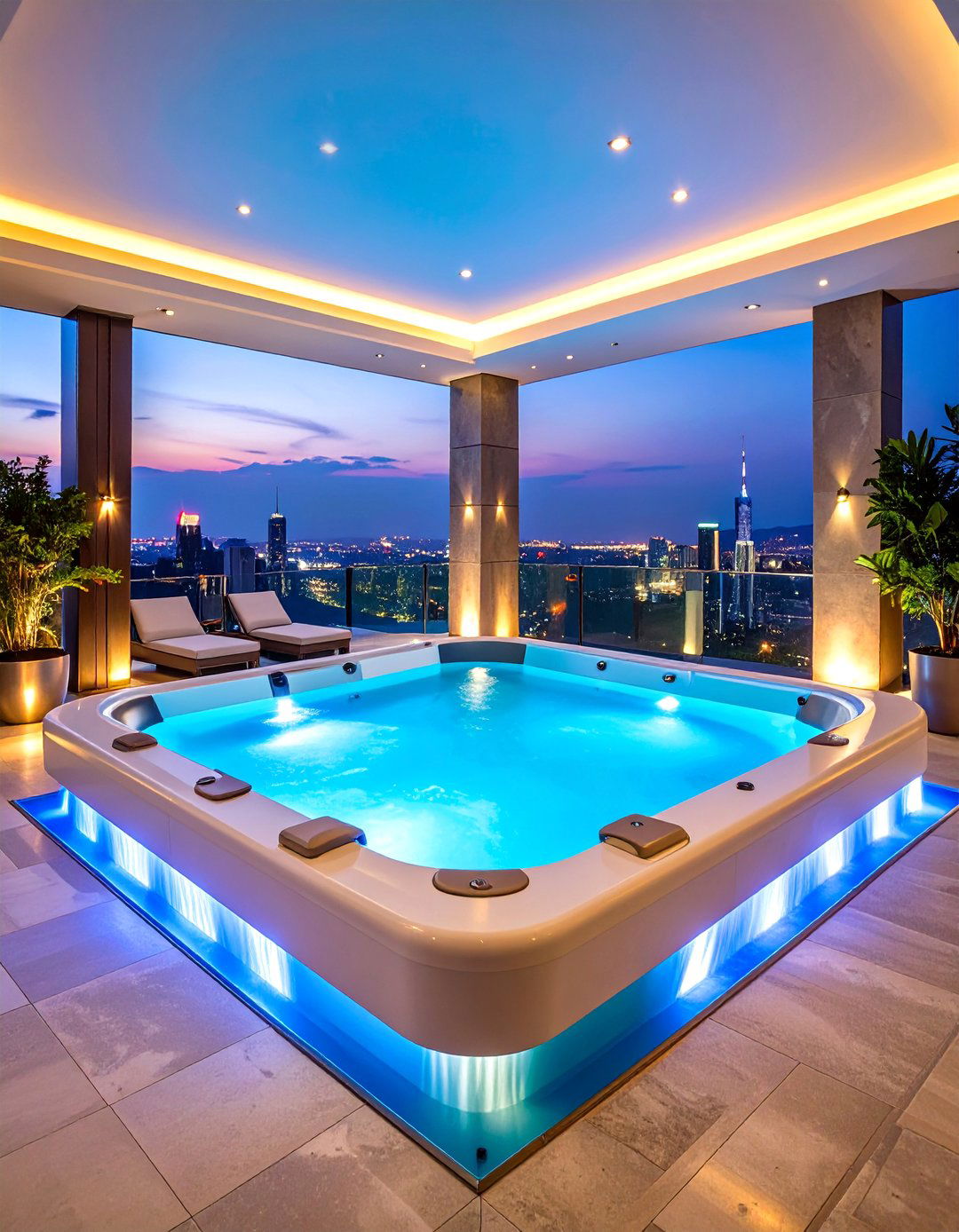

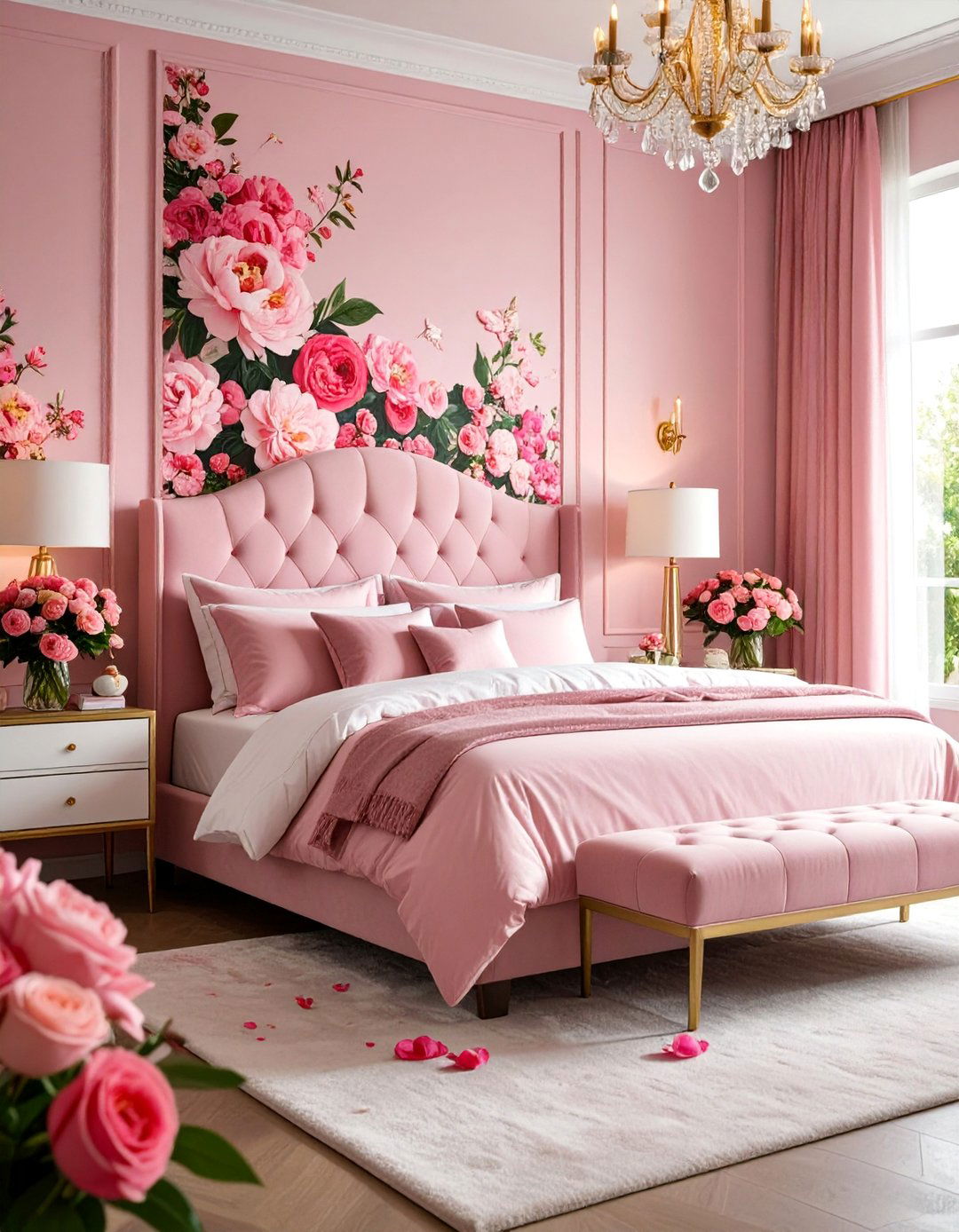
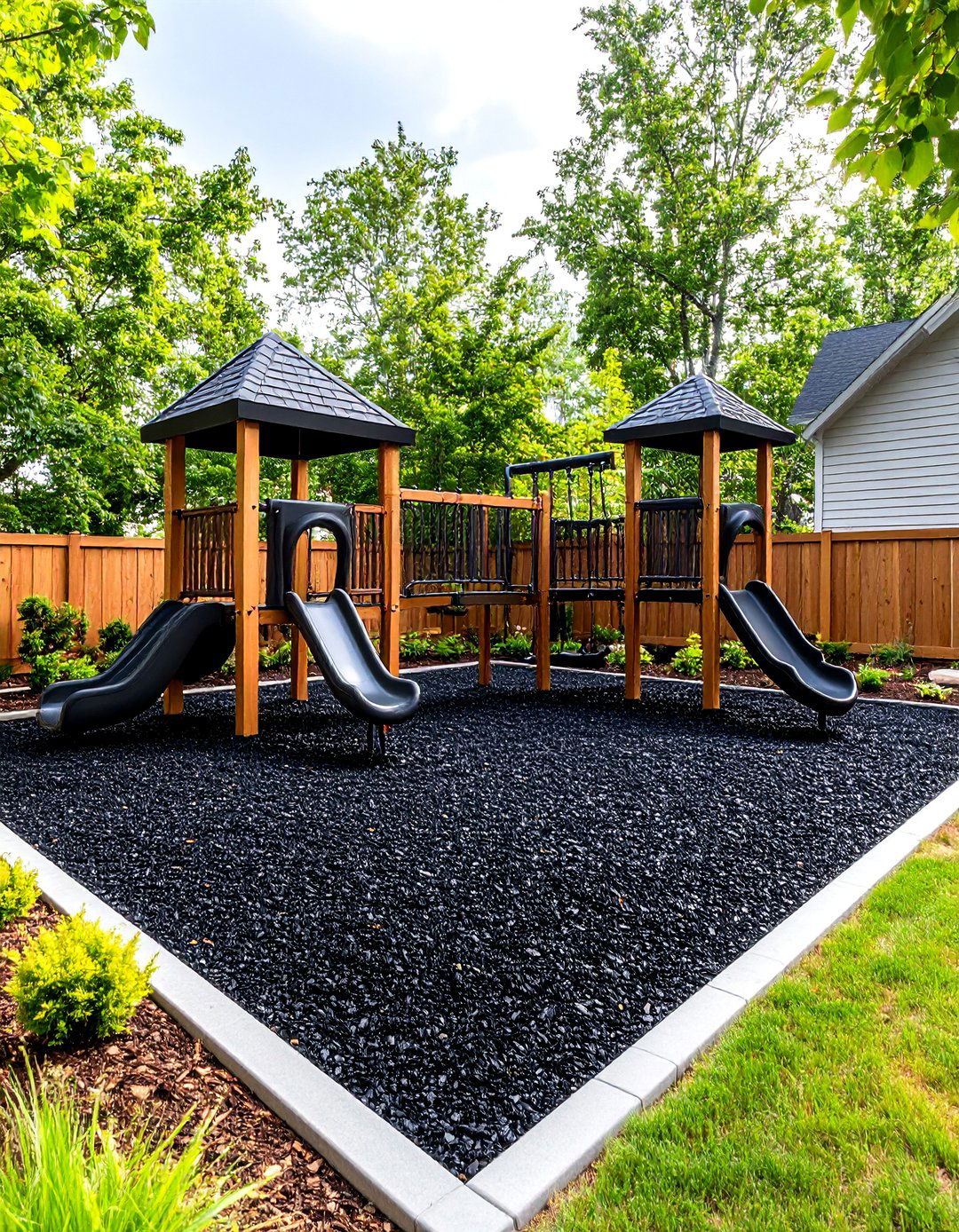

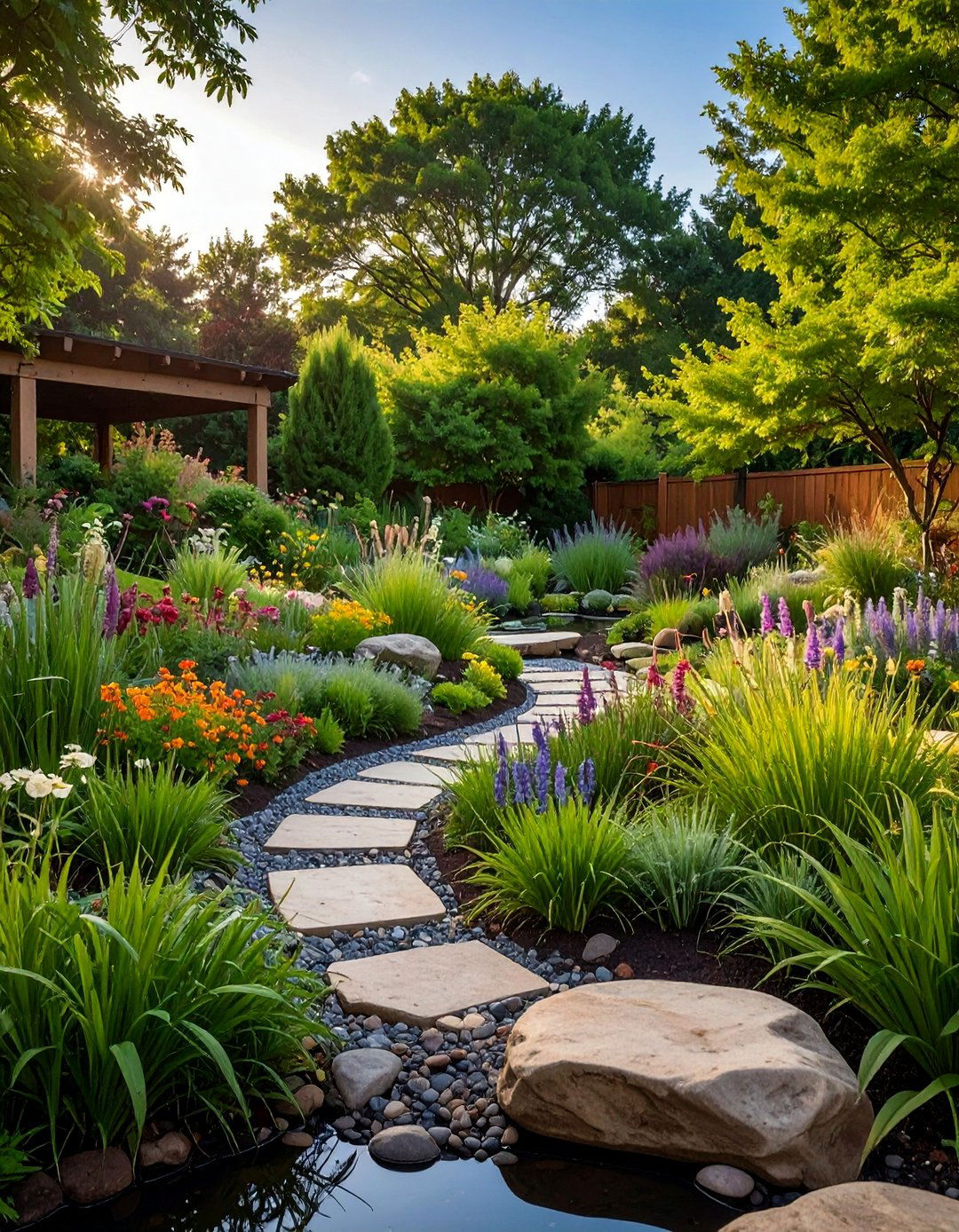
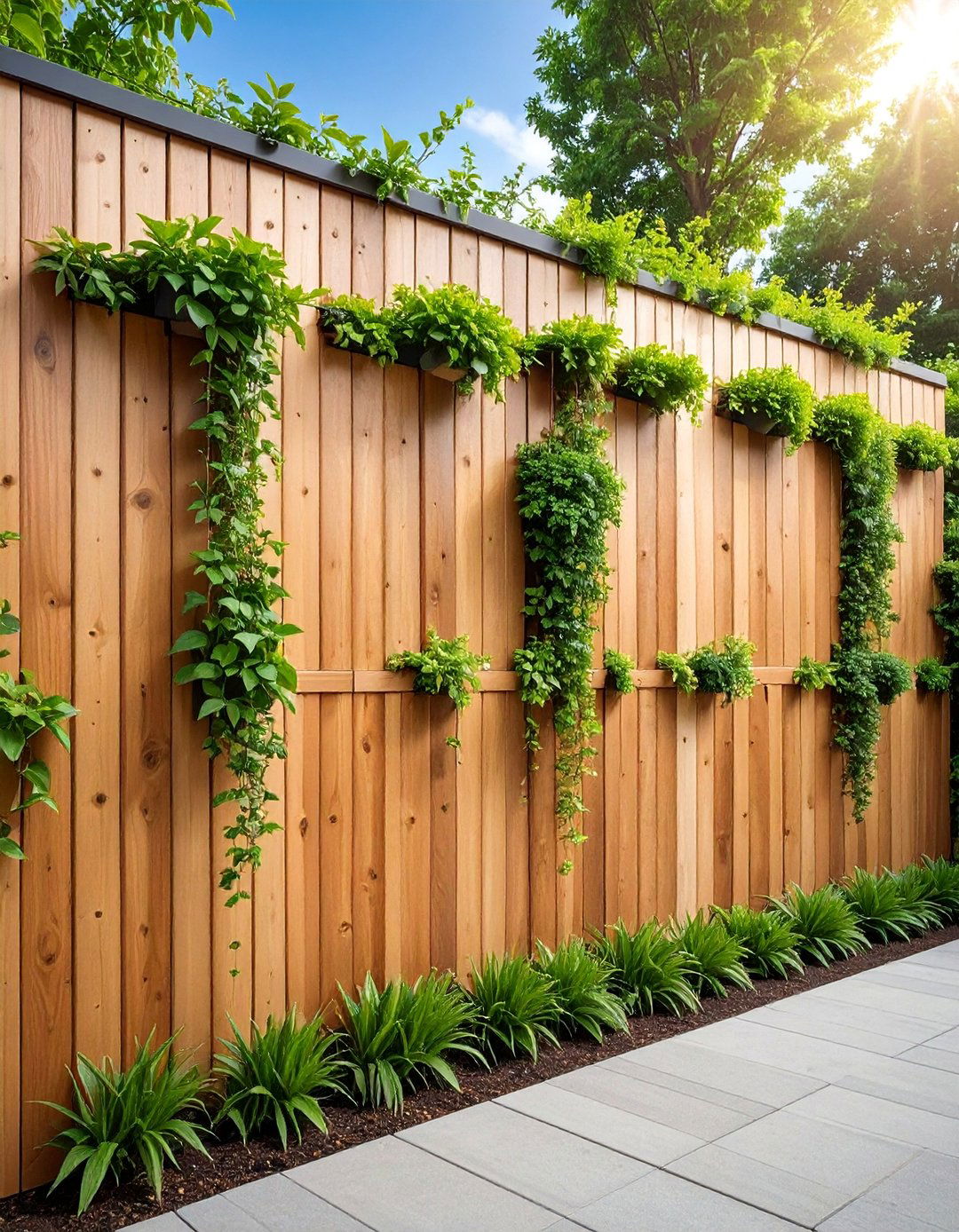
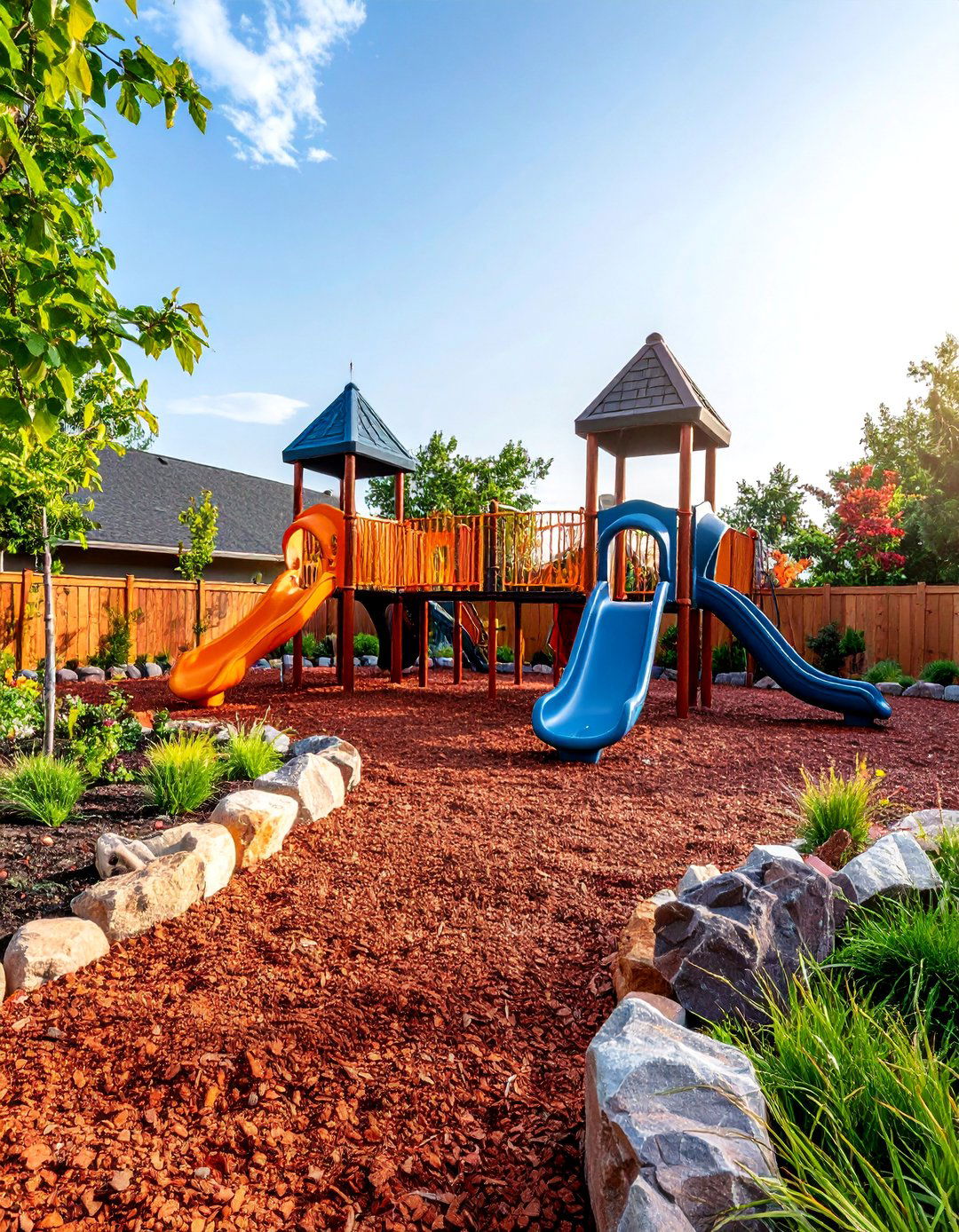
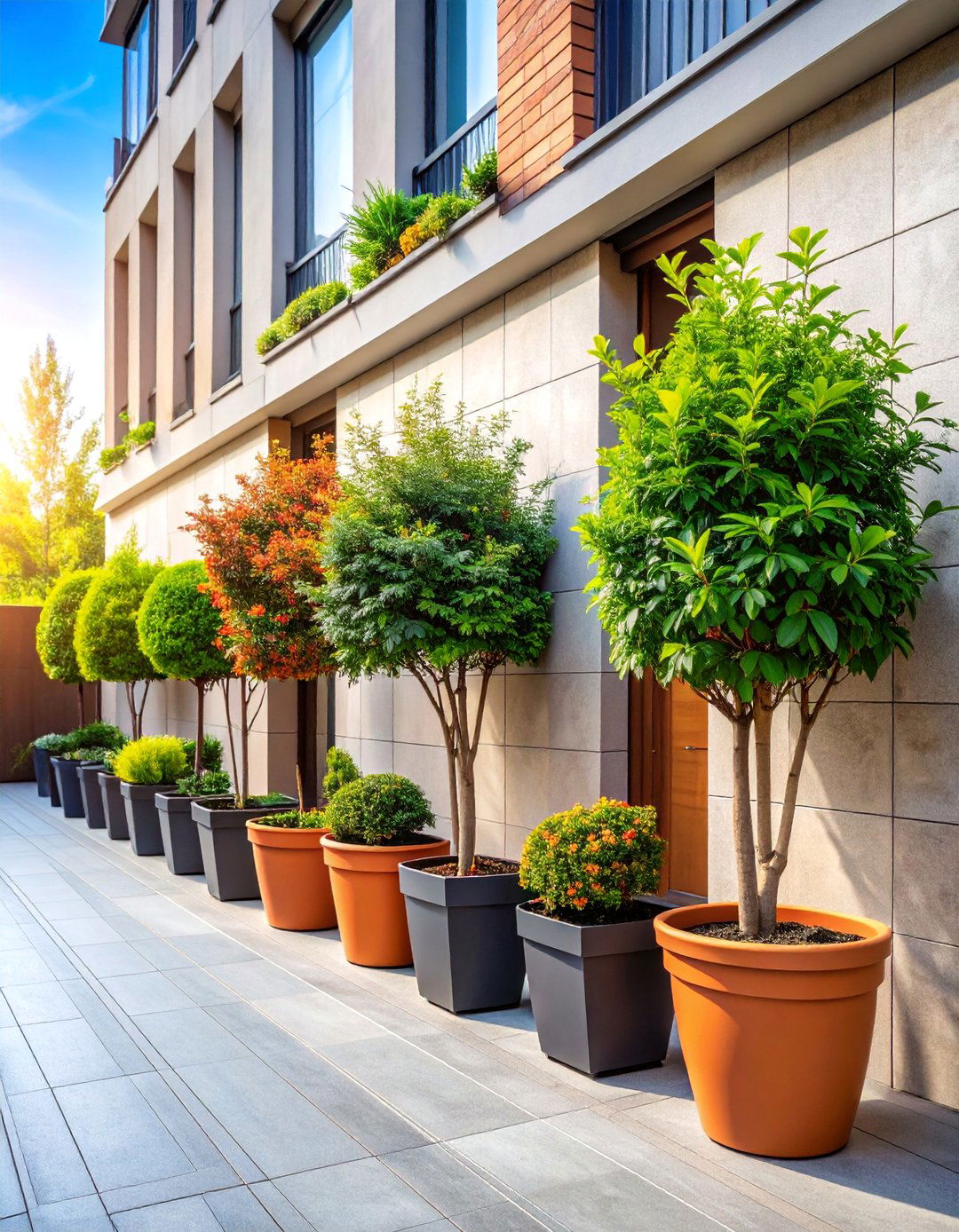
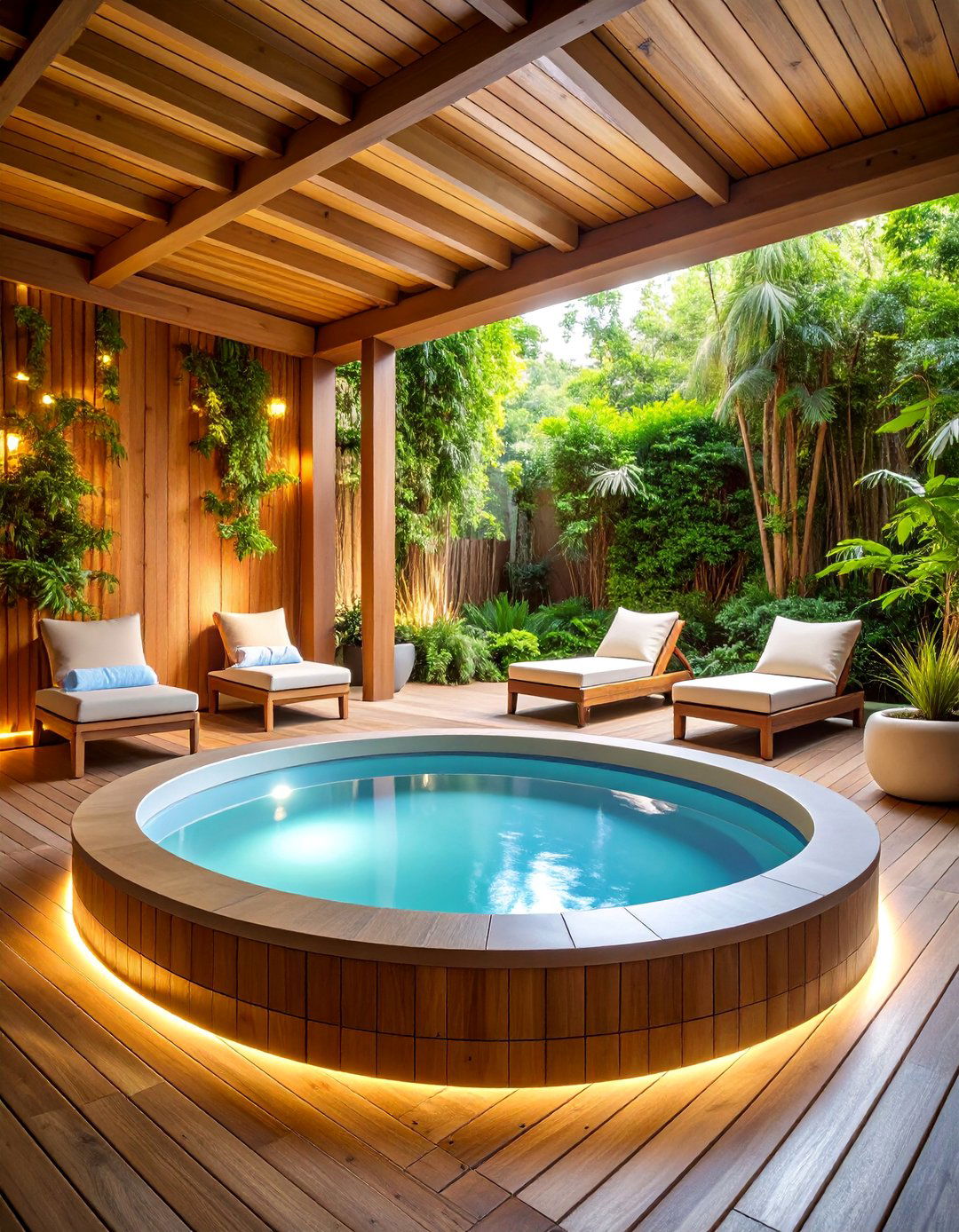
Leave a Reply